SOUTHAMPTON TOWN’S 375th ANNIVERSARY
—————————————————————
Early Republic & Economic Expansion
1777 / 1865
________________________________________________________

Battle of Sag Harbor, May 23, 1777, Sage Street
In 1777, during the Revolutionary War, Lieut. Col. Meigs captured the British garrison here. He also seized the British officers at James Howell’s Inn and destroyed a number of British ships and crucial provisions in the harbor. Meigs operated as a privateer from Connecticut where patriots fled after the Battle of Long Island (August 27, 1776). The Island became a British stronghold and the effect of this small, but flawless operation was a boost to the Continental Army suffering from a string of recent defeats. — Sag Harbor Historical Society.
______________________________________________
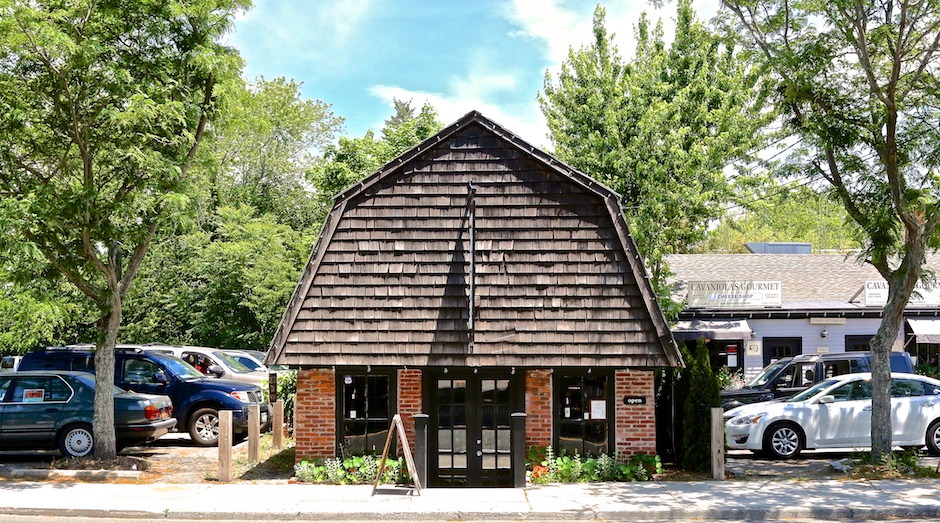
Umbrella House, c. 1775, Sag Harbor
Perhaps the oldest building in Sag Harbor, the tiny so-called “Umbrella House” is named for its distinctive gambrel roof form, which is thought to have been thatched in the early years. The building was used to quarter British soldiers in 1777 and later became an arsenal. It suffered cannon fire in the War of 1812 and has the scars to prove it! Later uses included a machinist’s shop, antiques store and currently a wine shop. — Historic Division, Southampton Town Clerk.
Historic Division, Southampton Town Clerk
______________________________________________
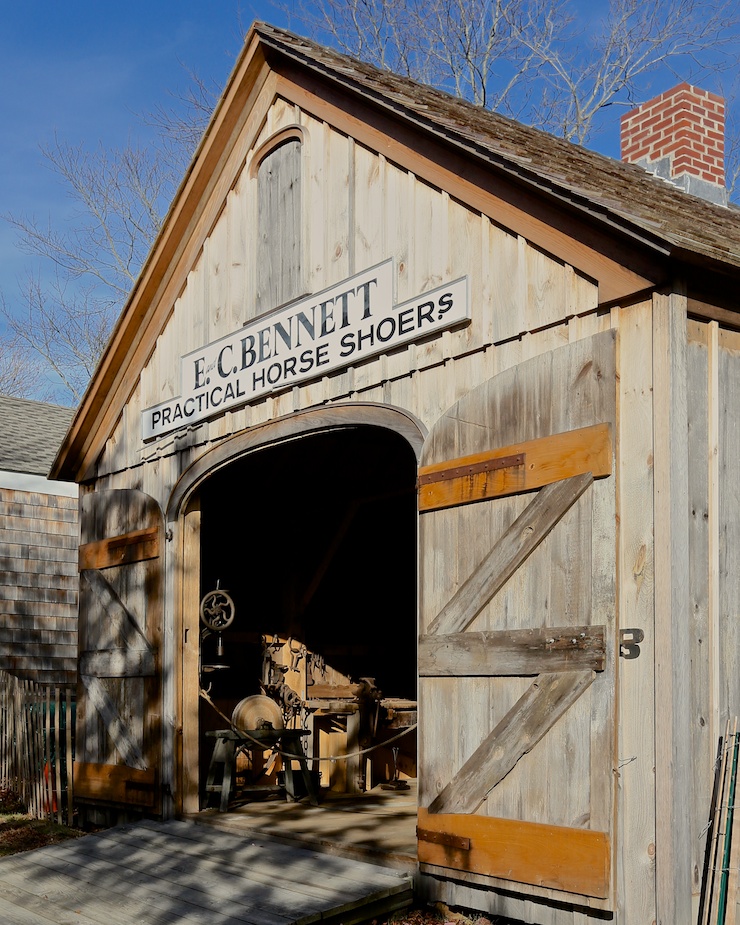
E.C. Bennett, c. 1780, Practical Horse Shoers, Southampton
The building that now houses the blacksmith shop was built circa 1780 and was located on Hampton Road near Main Street, where it served as a stable before it was moved to the museum circa 1977. The equipment on display came from James Burnett’s blacksmith shop on the east side of Halsey Lane in Water Mill when it went out of business in 1973. The signage, “E. and C. Bennett Practical Horse Shoer’s” was applied in commemoration of a blacksmith shop founded on Hill Street in Southampton in about 1890. — Southampton Historical Museum.
www.southamptonhistoricalmuseum.org
Visit: AAQ’s Landmarks — Rogers Mansion Museum Complex, Southampton
______________________________________________

Custom House, c. 1790, Sag Harbor
Sag Harbor was already a thriving maritime community when it became one of the first American seaports to be designated an official Port of Entry in 1789. For the next three decades, Henry Packer Dering, U.S. Custom Master, would be in charge of meeting the trading vessels and whaling ships which sailed into local waters. In this Federal house, Dering not only conducted customs business but raised nine children. — Society for the Preservation of Long Island Antiquities.
______________________________________________
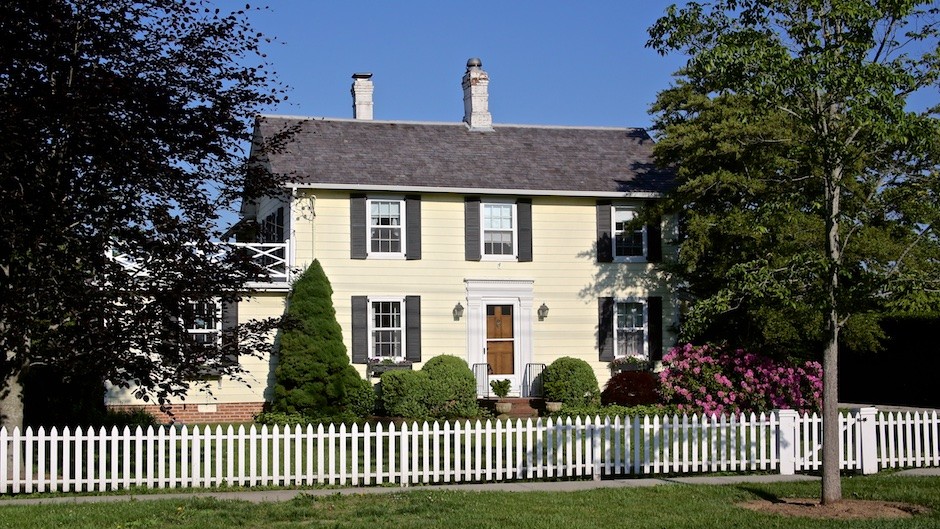
Polhemus-St. John House, c. 1790, Sagaponack
The timber-framed, two-story Polhemus-St. John House is a classic Long Island three-bay “half-house” that dates c. 1790. Its six-over-six window sash and large brick chimney appear to be original. The house was built by Nathan Pierson and later owned by Cook Hildreth. Nathan, who was the grandson of Theophilus and Sarah Pierson – both early Bridgehampton and Sagaponack residents – was born in Bridgehampton in 1748, but died in Richmond, Massachusetts, in 1826 at the age of 77. — Historic Division, Southampton Town Clerk.
Historic Division, Southampton Town Clerk
______________________________________________

Sybil Douglas House, c. 1790, Sag Harbor
This high-style, five bay Georgian house is noteworthy for its fine detail. It was built for Benjamin Huntting I who sent out the first successful deep sea whaling ship to Brazil in 1785. — Society for the Preservation of Long Island Antiquities.
______________________________________________
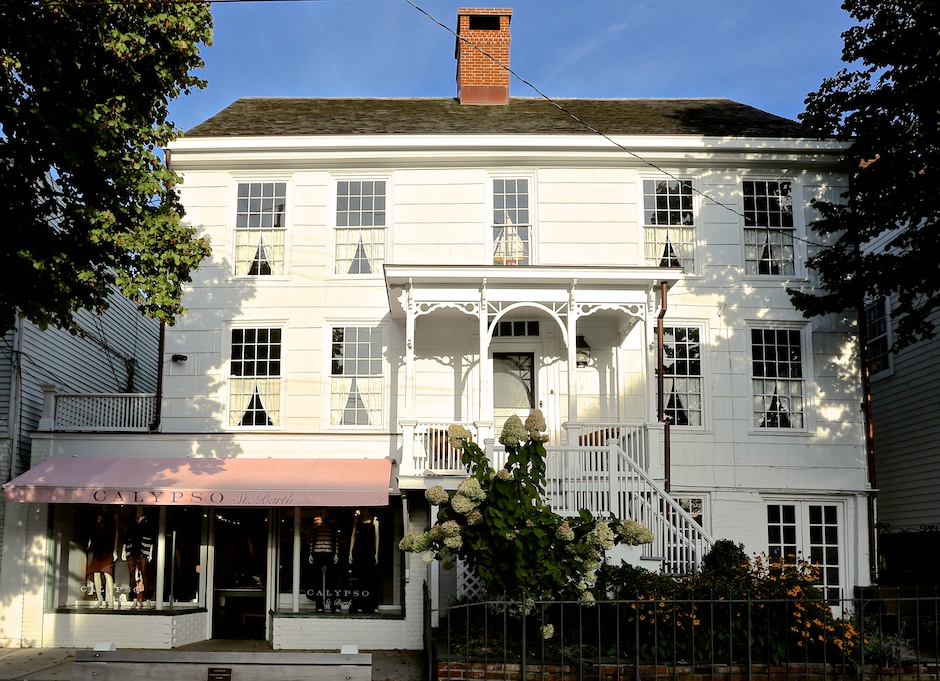
Peleg Latham House, c. 1790, Sag Harbor
Designed with a residence above and a commercial story at street level, the Peleg Latham House is a typical Sag Harbor merchant’s house of the Federal Period. –– Society for the Preservation of Long Island Antiquities.
______________________________________________
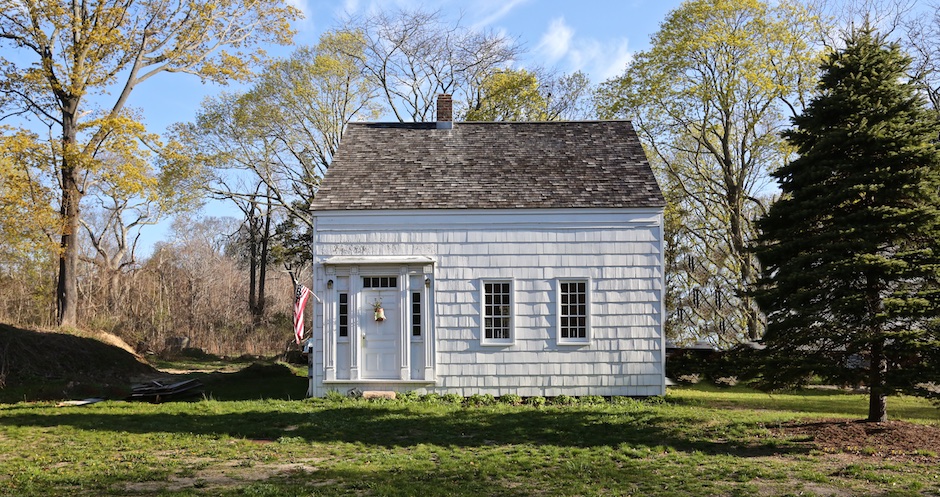
Prosper King House, 1790, Hampton Bays
It first served as the house of Prosper King and Mary Fanning. This exceptional early vernacular house is a half-Cape in form with a side-gable roof and an off-center entry on its front façade. Its exterior elevations and roof are clad in wood shingles and a small brick chimney rises from the roof ridge. The house appears to stand on a cobblestone foundation. An elaborate late Federal/early Greek Revival-style door surround includes sidelights flanked by pilasters and a molded entablature. The windows on the structure contain nine-over-six-light double-hung sash. A wide simple cornice defines the eaves line. — Town of Southampton
Southampton Town Landmark

Prosper King House, 1790, & Lyzon Hat Shop, 1850, Hampton Bays.
______________________________________________
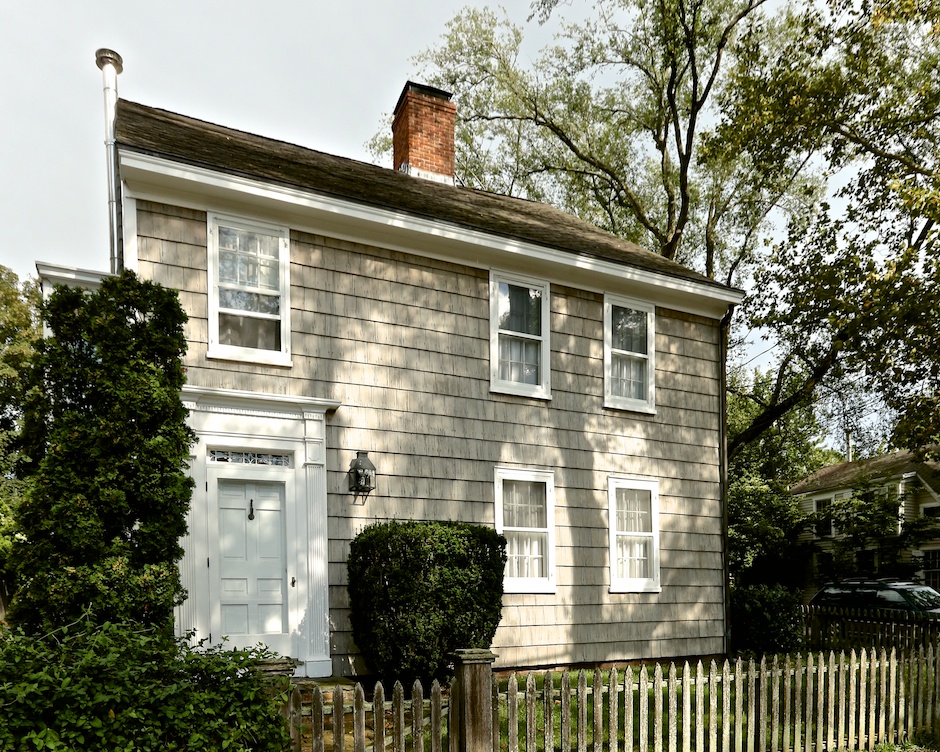
Prime House, c. 1795, Sag Harbor
The “half house” form, such as the Prime House, was popular in the Federal period. This 2-story, 3-bay home is a typical example of this vernacular style. — Society for the Preservation of Long Island Antiquities.
______________________________________________
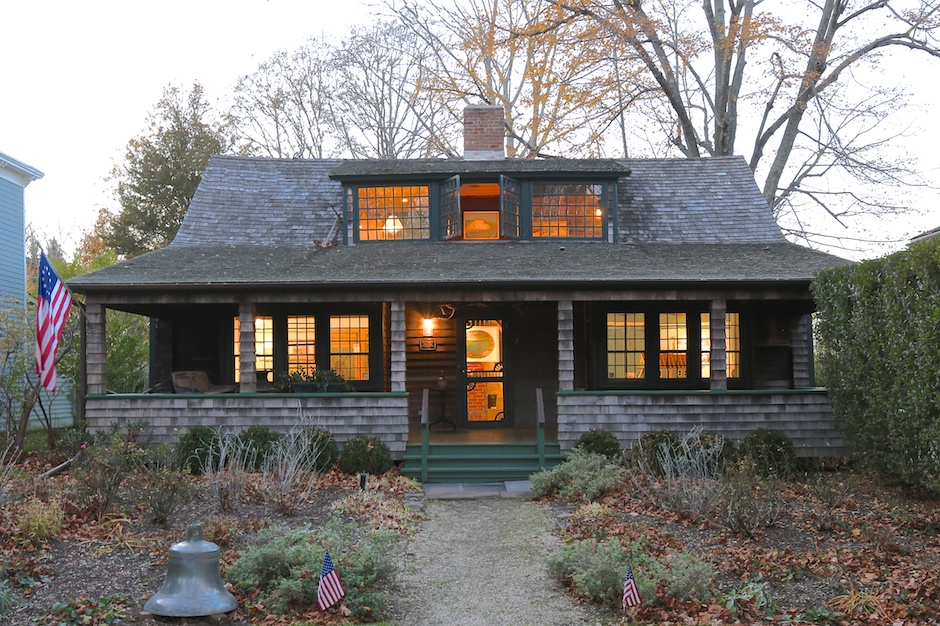
The Sag Harbor Historical Society–The Annie Cooper Boyd House, c. 1796
Originally this house was built as a Colonial half house in c1796 by Joseph Whitting Foster. The northern half was added by him in c. 1802. In 1871 William Cooper Jr. bought it for rental income. His daughter Annie Cooper Boyd, starting in 1904, added dormers, more windows, and a porch, transforming the house into a summer cottage her family named “Anchor to Windward.” Annie’s daughter Nancy Boyd Willey willed it to the Sag Harbor Historical Society in 1998, and restoration began in 2000. The house is open to the public, featuring its architecture, historical exhibits, and Annie’s paintings of old Sag Harbor. — Sag Harbor Historical Society.
______________________________________________
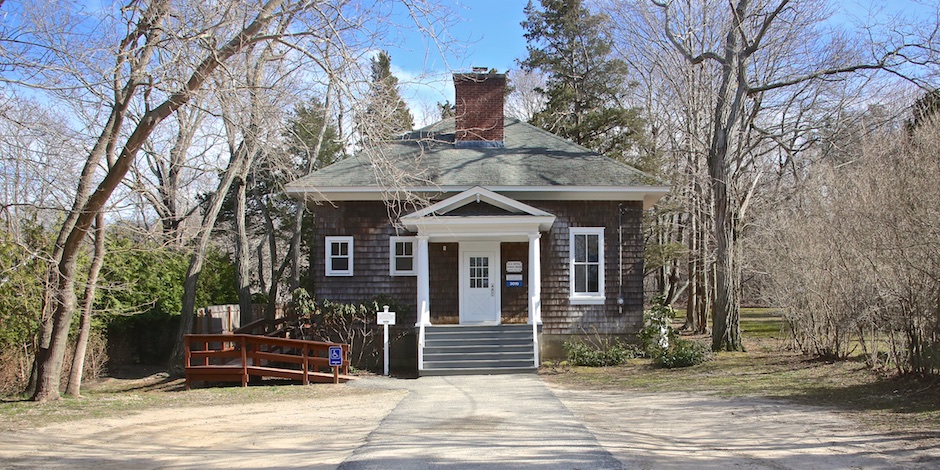
Old Noyac School House. Original circa 1796.
A three-bay hip-roofed building with a large brick chimney rising from its front roof slope, this structure is identified as the “Old Noyac School House.” “Original circa 1796” on a plaque on the front of the structure. The front entry of the house is accessed via a pedimented Neoclassical entry porch. The wood-shingle-clad structure is owned by the Town of Southampton and is the meeting place of the Noyac Civic Council. — Town of Southampton.
Town of Southampton Landmark
______________________________________________
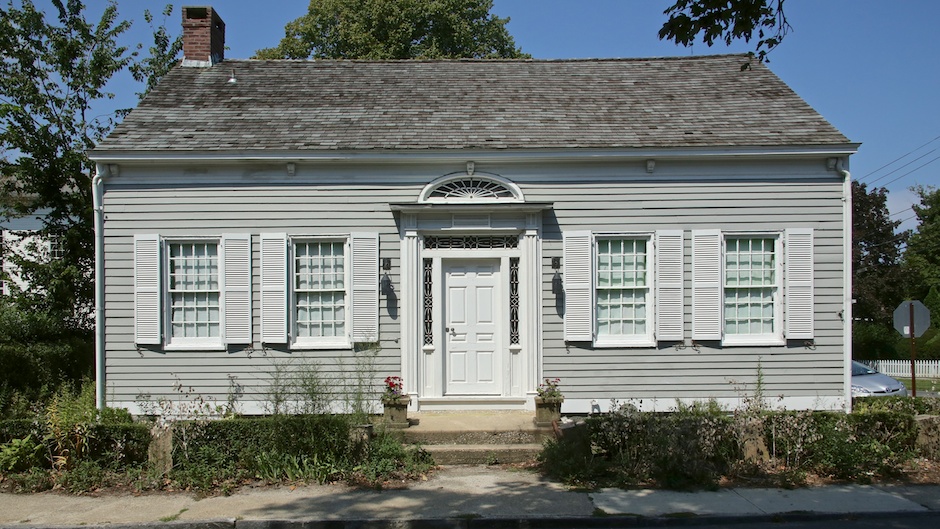
Jared Wade House, c. 1797, Sag Harbor
At the northwest corner of Union and Madison Streets is the modest but picture-perfect Jared Wade House, a Federal period gem built by Captain Jared Wade in 1797. Jared Wade (1776-1849) was the captain of whale ships and is buried at Oakland Cemetery. His one-story house preserves original 12-over-12 window sash, narrow clapboards and a beautifully articulated front doorway complete with an elliptical fanlight, leaded transom and sidelights, molded door surround and paneled door. — Historic Division, Southampton Town Clerk.
Sag Harbor’s Federal doorways or “frontispieces” are a delight to behold. This example is a vernacular masterpiece. Wade’s ship, the Montevideo, took Sag Harborites to the West during the 1849 gold rush. — Society for the Preservation of Long Island Antiquities.
______________________________________________

Matthew Topping House, c. 1797, Sagaponack
The timber-framed Matthew Topping House was built c. 1797, and is a “full” plan house of five bays and two stories with a pilastered front entryway. Later owners were Gardiner B. and Addison G. Topping. — Historic Division, Southampton Town Clerk.
Historic Division, Southampton Town Clerk
______________________________________________
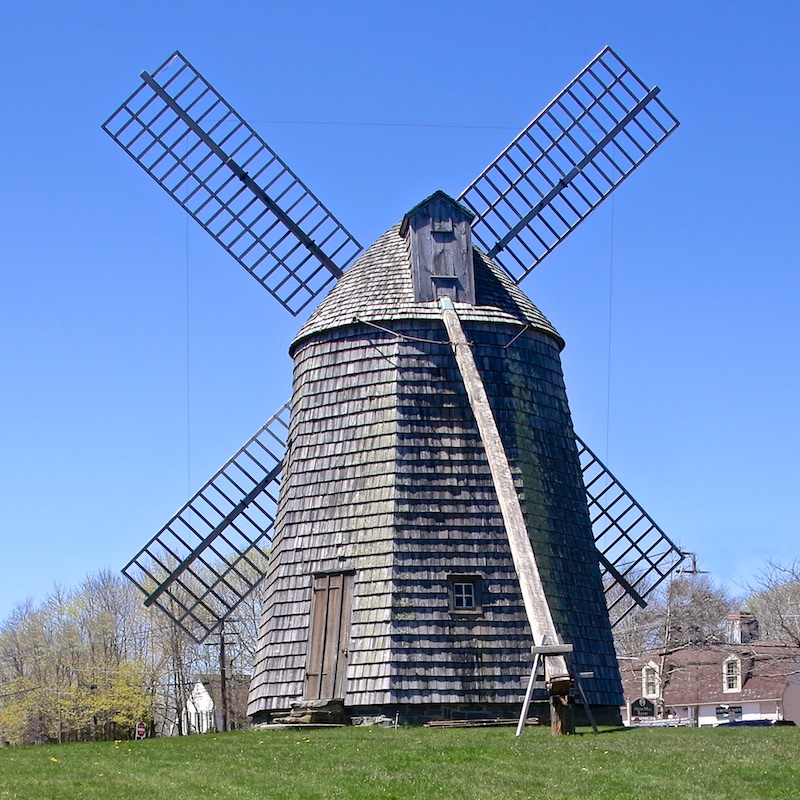
Corwith Windmill, 1800 / North Haven, 1813 / Water Mill
The State/National Register-listed Corwith Windmill, is located on the Water Mill Village Green. It is a two-and-a-half-story smock mill, built in 1800 in North Haven and moved to Water Mill in 1813. It is the only Long Island windmill whose cap is rotated by an external tail pole. It is currently owned and maintained by the Water Mill Improvement Association. — Town of Southampton.
New York State & National Registers of Historic Places
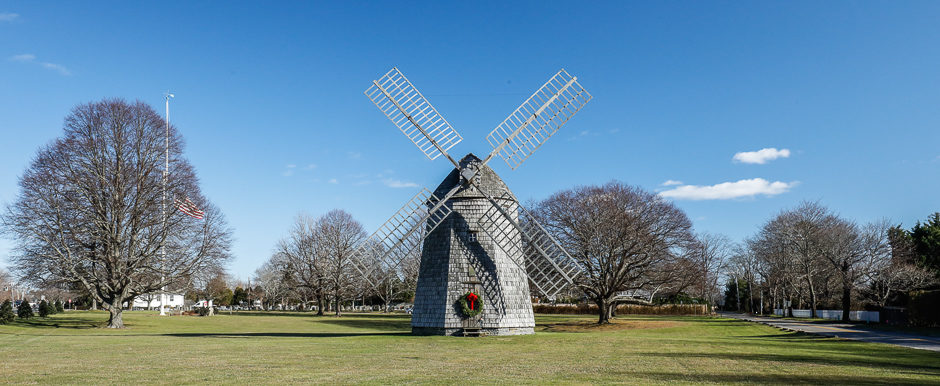
December 7, 2018
______________________________________________

Van Scoy House, c.1810, Sag Harbor
The Van Scoy house at the corner of Main and Jefferson Streets, opposite the Whaling Museum and next door to the John Jermain Memorial Library, is a late Federal period gem that boasts a gambrel shaped roof and fine architectural detailing. The house was built in 1810 by local carpenter/builder Benjamin Glover and occupied in the 1850s by Arnold Van Scoy, Sag Harbor’s first daguerreotypist. The bold cornice with modillion blocks and elaborate front door surround are characteristics of its early 19th century design. — Historic Division, Southampton Town Clerk.
Historic Division, Southampton Town Clerk
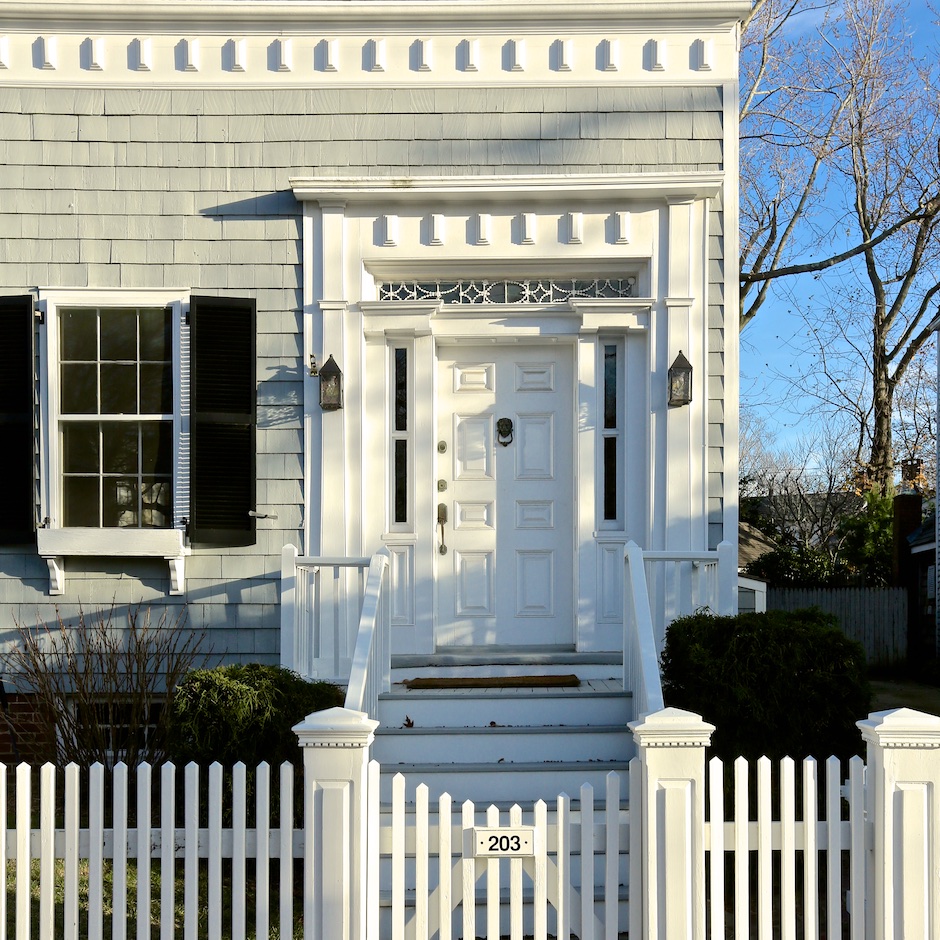
______________________________________________

Canoe Place Chapel, ca. 1820, Hampton Bays. Photo June 22, 2019.
The Canoe Place Chapel is a small wood-frame building that stands on a brick foundation on a rise off of Canoe Place Road. The building stands with its gable towards the road. It is clad in wide wood clapboards. A small enclosed entry porch is appended to the front elevation accessed by a flight of wood stairs leading up the embankment. This small building is believed to have been constructed ca. 1820 on another location in the locality (exact site unknown). A map dated 1848 shows the building standing on land south of its current location and designates it as an “Indian Meetinghouse.” The chapel served the local community of Canoe Place (also known as Warnertown) with parishioners of various ancestries including Native American, African-American, and Caucasian. — Town of Southampton.
New York State & National Registers of Historic Places.
Town of Southampton Landmark.
Visit: Restoration in Progress — Community Preservation Fund of Southampton
______________________________________________
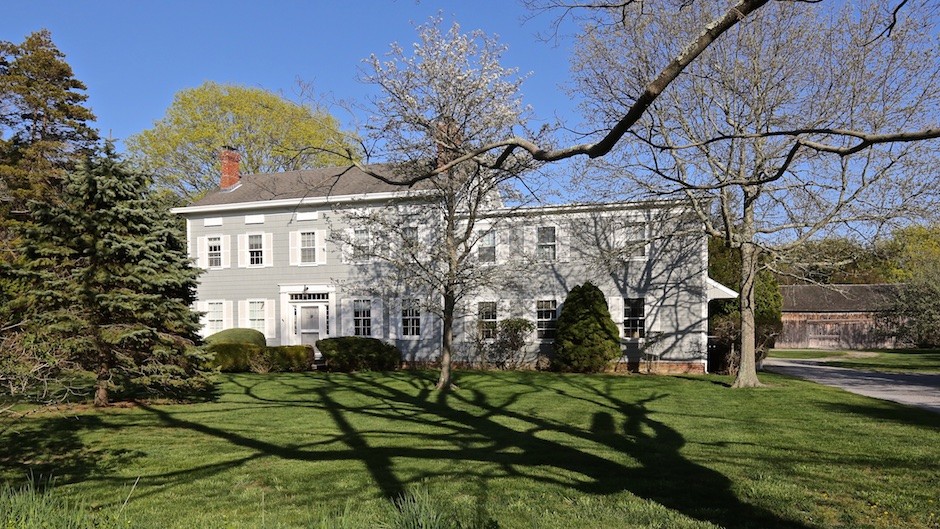
Capt. Henry Gardiner House, 1820s, Quogue
This classic, two-story, five-bay farmhouse was built in the 1820s. Its center door, gable roof with flared eaves, end chimneys and symmetrical fenestration are characteristic of the period. The front porch has been removed. The house was bought by Henry Gardiner in 1826 for $625. Gardiner was one of a handful of Quogue residents who went into the whaling industry; he became the captain of whale ships and traveled to the South Seas, before amassing a fortune and settling into retirement in the early days of Quogue’s Boardinghouse Era. — Historic Division, Southampton Town Clerk
Historic Division, Southampton Town Clerk
______________________________________________
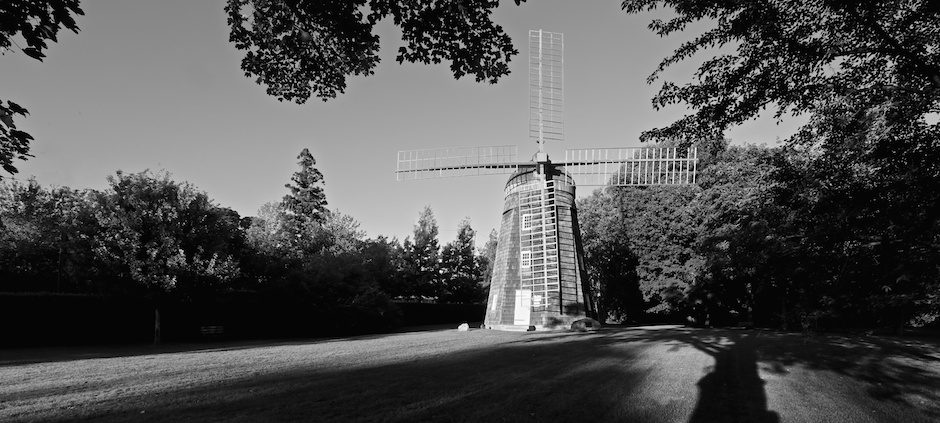
Beebee Windmill, 1820, Sag Harbor, relocated to Bridgehampton, 1915.
The Beebee windmill was built on Sleight’s Hill, Sag Harbor, in 1820 for Lester Beebee, a retired whaling captain and shipbuilder. The construction was undertaken by Pardon Tabor, a local woodworker and fine craftsman, and Samuel Schellinger, an Amagansett millwright. At the time of completion, the Beebee Windmill was the tallest structure in Sag Harbor. It was the miller’s custom to hoist a flag from the top of the curved ogee cap whenever a homeward bound whaling vessel was sighted in the Bay. The local expression to describe the event was “Flag on the mill, ship in the Bay.”
Following Lester Beebee’s death, his brother sold the mill to Judge Abraham Topping Rose, a descendent of one of Bridgehampton’s original settlers, and Richard Gelston, owner of The Bull’s Head Tavern. Rose and Gelston had the massive mill hauled down the turnpike to Bridgehampton and placed on a high piece of ground just north of the present Presbyterian manse. For the next half century it operated there under a succession of different owners, including Charles Norris, Major Roger Francis, Squires Hedges Miller, Charles Topping, E. Jones Ludlow, Albert Topping and Lafayette Seabury.
In 1882, the mill was purchased by James A. Sandford who moved it for the second time in 1888 to a site near the railroad station. To lessen the mill’s dependence on the vagaries of wind, Sandford subsequently installed a steam engine in the mill. In the same year, Nathanial Dominy VII, scion of a long line of windmill builders and clockmakers, made extensive repairs to the mill. In 1899, the mill was purchased by Oliver Osborne and moved to the north side of the railroad tracks. In 1900, the mill was sold to the Bridgehampton Milling Company, which operated it for many years.
In 1915, John E. Berwind, an affluent Bridgehampton summer resident, bought the mill and moved it to the grassy green next to Minden, his summer estate. Berwind, a Pennsylvania industrialist and an enthusiastic supporter of local causes, was instrumental in establishing the Community House, located in the center of the Village of Bridgehampton. It was fitting, therefore, for his widow to will the Beebee Windmill and two acres of land on which it stands to the Town of Southampton as a memorial to her late husband. — Bridgehampton Historical Museum.
www.bridgehamptonhistoricalsociety.org
______________________________________________
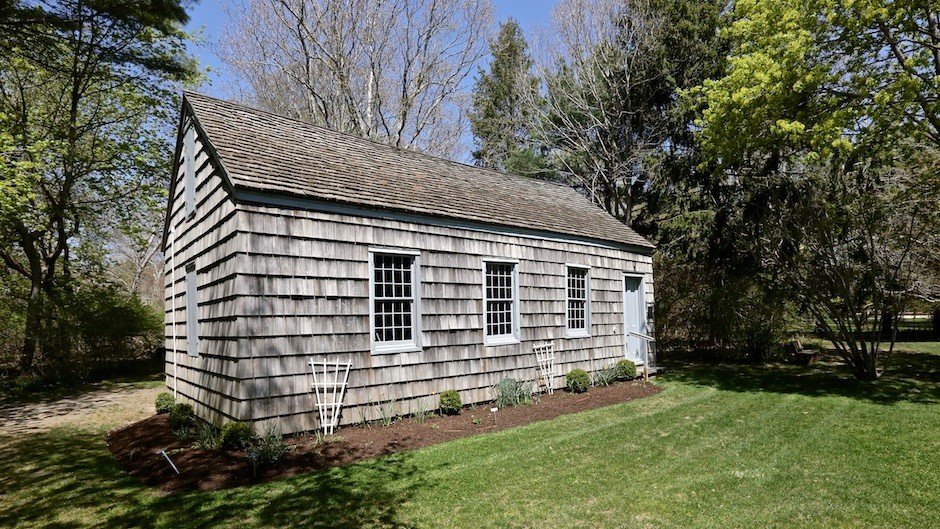
Old Schoolhouse, 1822, Quogue
The Old Schoolhouse Museum, located directly behind the c. 1896 Quogue Library, was built in 1822 and is one of the oldest schoolhouses in Suffolk County. It originally stood on the north side of Quogue Street near the present site of Old Depot Road and is now operated by the Quogue Historical Society. Quogue School District No. 3 was one of the first set up in Southampton Town, and was one of a group of Common School Districts established by NY State education law in 1812. Moved three times in its career, the Old Schoolhouse Museum was relocated behind the library in 1948. Quogue’s second schoolhouse was built in 1893 on Jessup Avenue. — Historic Division, Southampton Town Clerk.
______________________________________________

Sayre Barn, Southampton, 1825. Restored, 2014.
The Sayre Barn was built in 1825 by the Huntting family and sold to Isaac Sayre a year later. Originally located at the corner of Main Street and Hampton Road, it housed Mr. Sayre’s livestock and stored goods. For many years it was known as the “Billboard Barn” because its location made its façade an ideal place to post signs and notices. In the 1930s, when it was owned by the Dimon family, it was made into an antiques store. After World War II the Dimon family gave the barn to the Colonial Society, which became the Southampton Historical Museum, and in 1952 it made the trip down Main Street to the museum property on Meeting House Lane. In 2010, considered seriously deteriorated, the barn was named to the Society for the Preservation of Long Island Antiquities’s list of endangered structures and a campaign was launched to restore it. In the spring of 2013, specialists in historic restoration Strada Baxter Design were given the task of returning the Sayre Barn to its original state. —– Southampton Historical Museum.

Archival postcard courtesy of the Southampton Historical Museum.
www.southamptonhistoricalmuseum.org
______________________________________________
 Mile Markers: Hill Street & Hampton Road
Mile Markers: Hill Street & Hampton Road
Stone mile markers are rare survivors today, relics of early travel often located too close to the
roadway to withstand the widening, maintenance and high speed traffic of today. But two remain in Southampton Village, each declaring the distance from Southampton to nearby hamlets including Good Ground (Hampton Bays) and Quogue to the west and Water Mill and Bridgehampton to the east. Mile markers were helpful to travelers in the stage coach era, providing useful information that translated into the time left in ones journey. The mile markers in Southampton Village date from the early to mid-19th century. — Historic Division, Southampton Town Clerk.
Historic Division, Southampton Town Clerk
______________________________________________
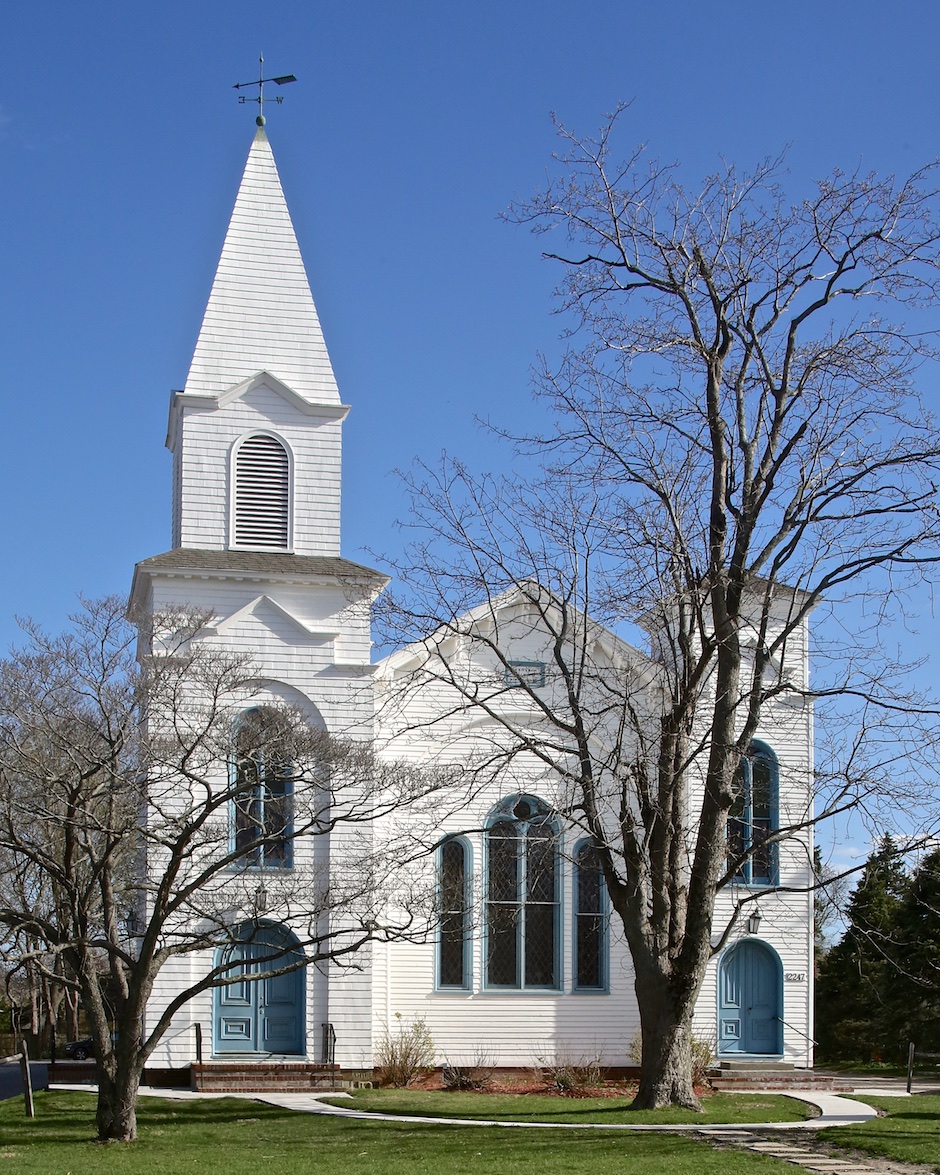
Bridgehampton United Methodist Church, 1833
The Bridgehampton United Methodist Church was constructed in 1833 on another lot on Montauk Highway. Due to an expanding congregation, the church was moved to its current site and substantially expanded in 1871. The upper portion of the steeple was rebuilt, probably in the early 20th century. — Historic Division, Southampton Town Clerk.
Historic Division, Southampton Town Clerk
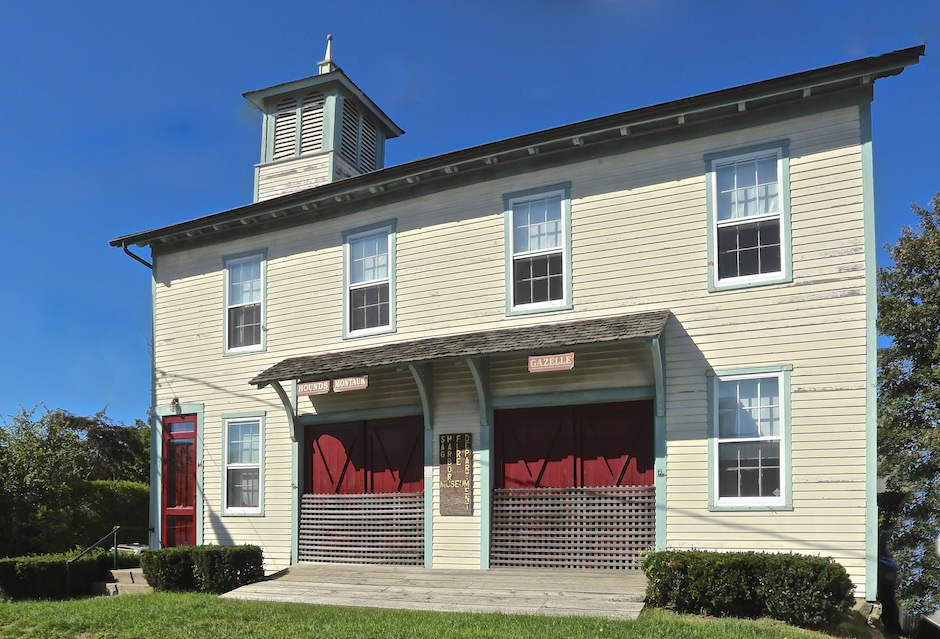
Fireman’s Museum, c. 1833, Sag Harbor
Built by the first Presbyterian Church as a meeting hall in 1833, this structure was acquired by the village in 1856 to serve as a schoolhouse, municipal hall and jail. By 1896, it housed the Montauk Hose Co. and Gazelle Hose Co., and since 1978 it has displayed exhibits related to firemen and fire fighting in Sag Harbor. Notable fires in downtown Sag Harbor included those of 1817, 1845 and 1877. — Historic Division, Southampton Town Clerk.
Historic Division, Southampton Town Clerk
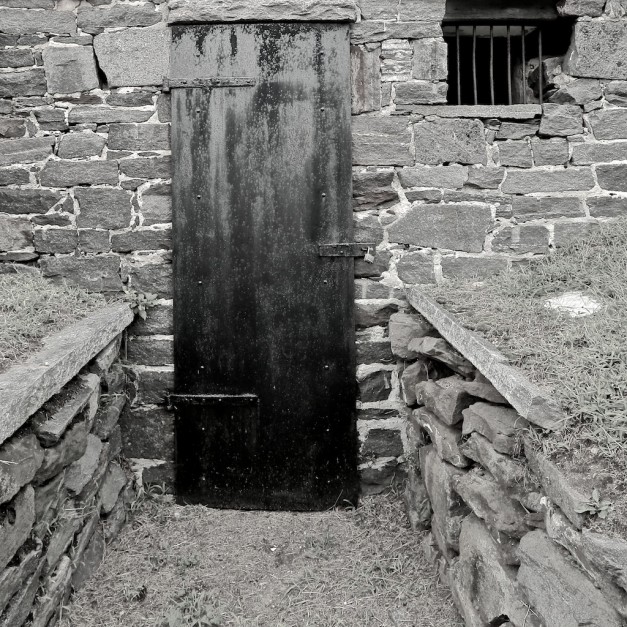
______________________________________________
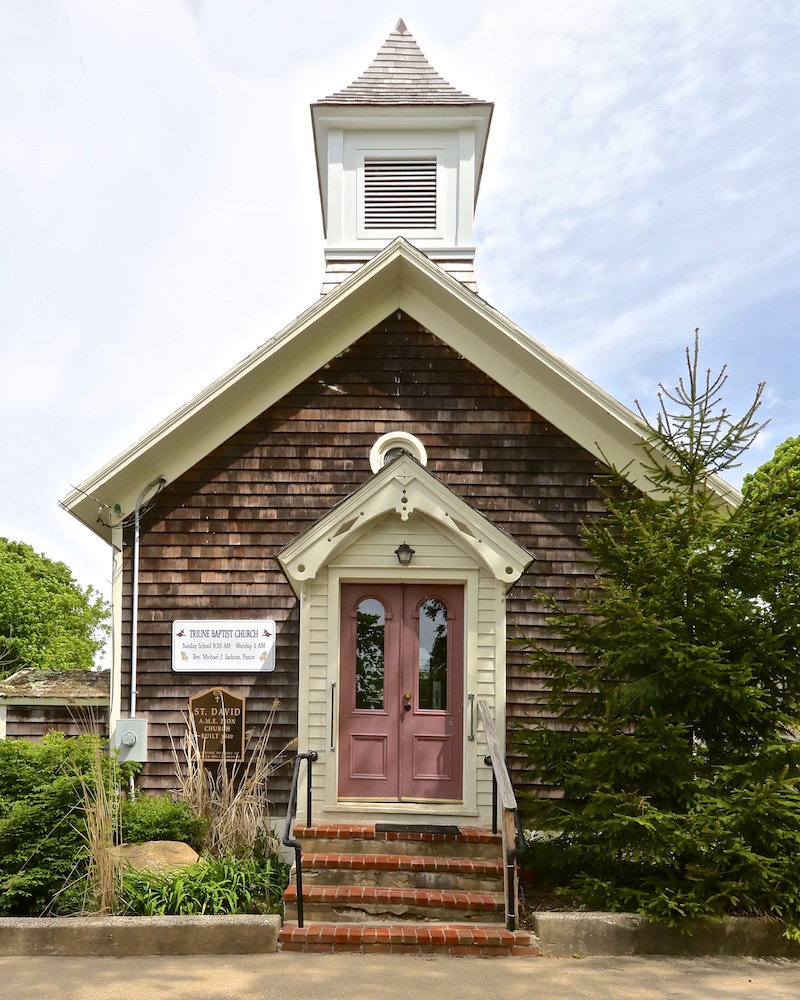
St. David A.M.E. Zion Church, 1839, Sag Harbor
St. David A.M.E. Zion Church was built for African Americans and Native Americans. It is widely believed to have been a stop along the Underground Railroad. The founding Paster, Rev. P. Thompson was a noted Abolitionist and friend of Frederick Douglass. –— Historic Division, Southampton Town Clerk.
______________________________________________
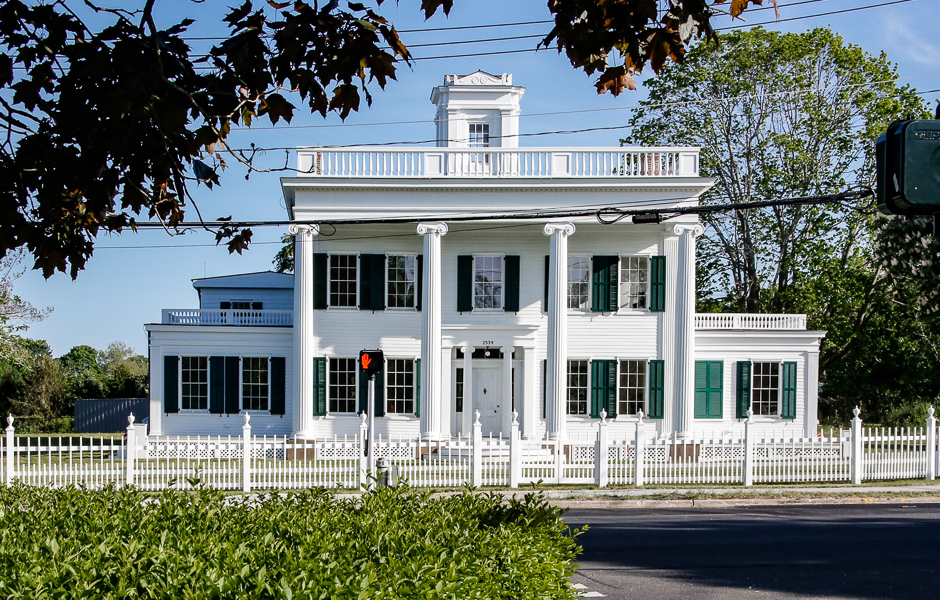
Nathaniel Rogers House, 1824 / 1840, Bridgehampton
Many summer residents who chose to stay in Bridgehampton into the colder months boarded at the Hampton House, as many of their cottages were not winterized. The inn did not just serve summer guests; it also held oyster suppers, church socials, euchre card parties, dances, and “hops,” as they were called, for the community at large year-round. The Frank Hopping family continued to operate the inn for the next 50 years, until 1949, when it reverted back to a private residence for the Hopping family.
In 2003, the Bridgehampton Historical Society (now the Bridgehampton Museum) purchased the house and donated it to the Town of Southampton, maintaining a long-term stewardship of the building. The museum’s goal is to make the Hampton House, now known as the Nathaniel Rogers House, a historic landmark that will serve as it headquarters and a cultural resource center for the community. — Julie Green, Bridgehampton, Images of American / Arcadia Publishing.
This house was originally a Federal period house with a five-bay, center-hall plan and symmetrical front parlors built in 1824 for Abraham T. Rose, a county judge. In 1840, it was transformed by its second owner, Nathaniel Rogers into a Greek Revival residence with the addition of a monumental temple front, a cupola, and ornamental balustrade railings. Nathaniel Rogers was the son of a famous patriot of the Revolutionary War, apprenticed to a shipbuilder, and then studied under artist Joseph Wood to become a noted miniaturist himself. — Historic Division, Southampton Town Clerk.
Donations to help restore the Nathaniel Rogers House, please contact the Bridgehampton Historical Museum at www.bridgehamptonhistoricalsociety.org
Town of Southampton Landmark
New York State & National Registers of Historic Places
AAQ / Resource / Education / Books — Click Here.
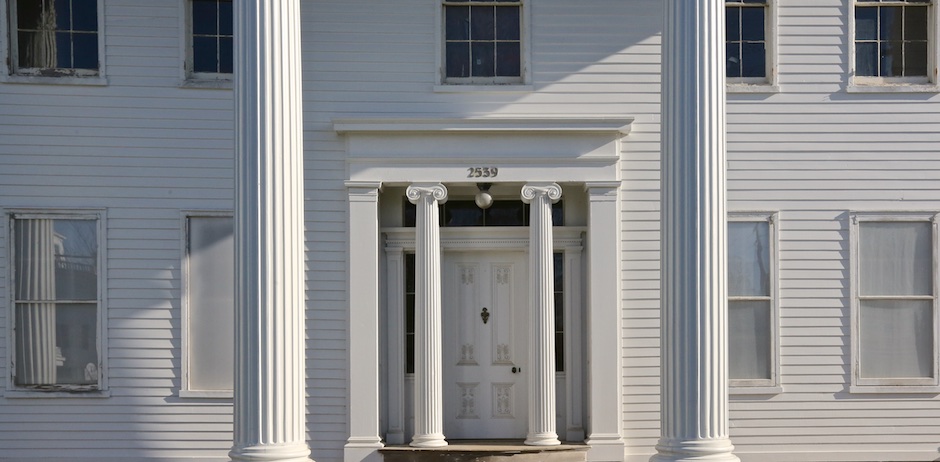
—- May, 2015 —-

—- November 28, 2018 —-
Visit AAQ / Restoration Portfolio: Nathaniel Rogers House, Bridgehampton
—- December 19, 2020 —-

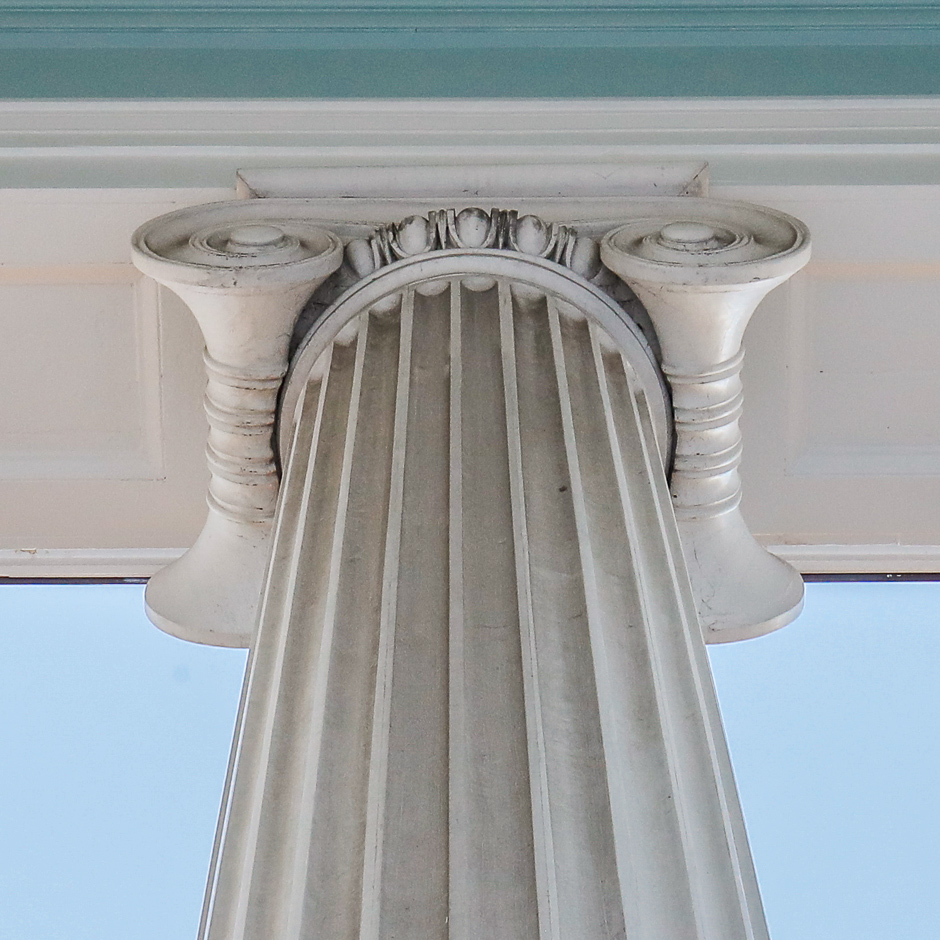
—- December 3, 2020 —-

______________________________________________

Methodist Church, c. 1835 / 1864, Sag Harbor
Originally built on High Street in 1835, the Methodist Church was moved to this location in 1864. Local inventor and clockmaker Ephraim Byram provided the original church steeple with its tower clock, but that was replaced with an Italianate style campanile in 1864, which blew down in the Hurricane of 1938. The front doors are said to have been inspired by the famous bronze doors of the Baptistry in Florence, Italy. — Historic Division, Southampton Town Clerk
———–
In 2021, a cultural center, known as The Church, opened in the deconsecrated church, offering an exhibition space & artist residency. For further information, visit: www.thechurchsagharbor.org
______________________________________________
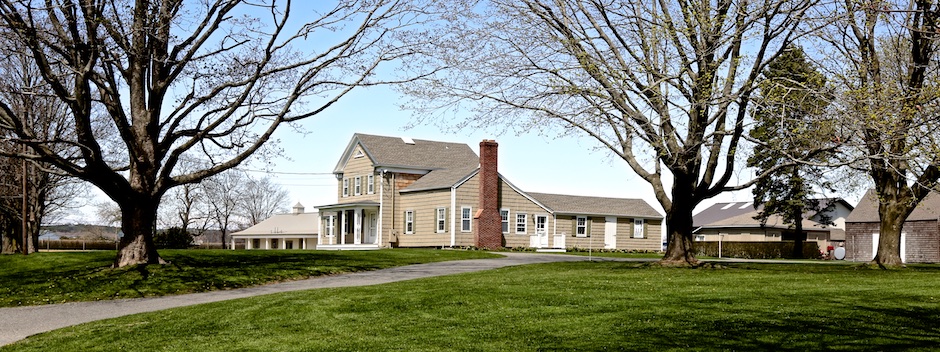
Halsey Farmhouse, ca. 1840, Water Mill
This front-gable Greek Revival-style farmhouse with triangular gable window and side ell is clad in wood shingles. It has been in the Halsey family since its ca. 1840 construction, and is still part of a working farm. — Town of Southampton.
______________________________________________
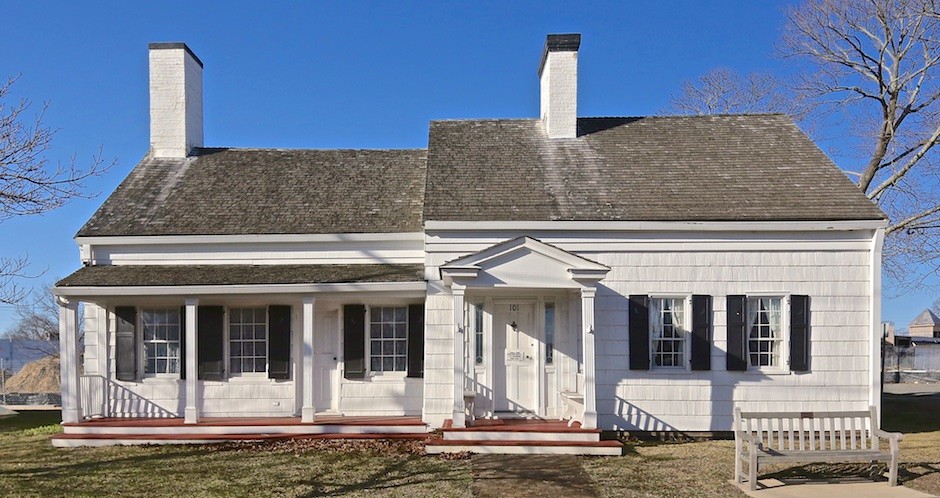
Josiah Tuthill House, 1840, Remsenburg, later moved to Westhampton Beach.
The house was built in 1840 by Josiah Tuthill. Josiah was a grandson of John Tuthill who came from Southold about 1760 to become a first settler of Speonk (later renamed Remsenburg).The house was originally located on South County Road, a wide avenue made truly beautiful by lovely Colonial and Victorian homes fronted by white picket fences and stately trees.
In the mid to late 1890’s the house served as the local post office and gathering spot, with Josiah Tuthill’s son, Gilbert, acting as Postmaster. In 1954 the house was sold and floated by bay to Quiogue, at a site on Foster Lane. In 1990, the house was donated to WHBHS. By 1991, the quaint old farmhouse was once again on the move—this time to its current site on Mill Road, Westhampton Beach.
With dedication, commitment and community support, the Westhampton Beach Historical Society opened the totally renovated house-museum to the public in 1995. — Westhampton Beach Historical Society.
______________________________________________

“Cooper Hall” (Mercator Cooper House), 1840s, Southampton
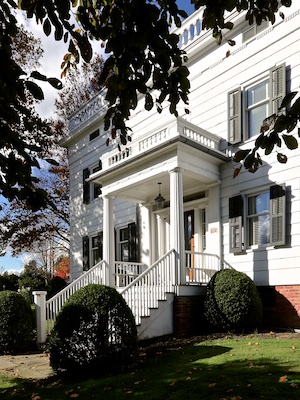
The two-story, Greek Revival style “Cooper Hall” with its prominent roof railing and formal entryway is a part of the Rogers Memorial Library complex, but was built in the 1840s as home of Mercator Cooper. Cooper (1803-1872), born in Sag Harbor and a captain of whale ships, is credited as the first American to visit Tokyo, Japan (1845) and Antarctica (1851). Under Cooper’s command, the whale ship Manhattan rescued Japanese sailors and returned them safely to the mainland. Two of his crewman were of special interest – African American sailor Pyrrhus Concer and Native American Shinnecock Eleazer – the first men “of color” the native Japanese had ever seen. — Southampton Historical Museum.
www.southamptonhistoricalmuseum.org
~~~~~~~~~~~~~~~~
In March, 1845, Captain Mercator Cooper, commanding the Manhattan, found 11 shipwrecked Japanese sailor’s near St. Peter’s Island in the Pacific. Although American ships were forbidden in Japanese waters, Cooper felt the Japanese castaways should be safely returned to their country in a gracious manner. On the way to Japan, near the Bonin Islands, Cooper found 11 more shipwrecked Japanese sailors with a cargo of pickled salmon and valuable Japanese maps and charts.
When the Manhattan arrived in Tokyo’s harbor, Cooper had his passengers ask the Emperor’s permission to anchor and let the crew onto land for water and other provisions. Before receiving the Emperor’s reply, the Manhattan was surrounded by three rings of Japanese boats. The Americans were then given a drawing of a man with a sword drawn across his throat — meaning if they came ashore they would be killed. Cooper kept his men on board. However, many Japanese noblemen came aboard to investigate the strange American ship and crew…
The Emperor sent wood, rice, rye, vegetables, crockery, and other gifts to Cooper in thanks for returning the shipwrecked Japanese. The governor of Tokyo personally brought the Emperor’s words of praise, and the Emperor sent Cooper his autograph. After four days in Tokyo harbor, Cooper prepared to leave, and asked the Japanese what to do should he find Japanese castaways on another occasion. The governor said not to return to Japan under any circumstances…Cooper’s visit to Japan preceded Admiral Perry’s visit by eight years.
— Guide to Sag Harbor: Landmarks, Homes & History, by Henry Weisburg & Lisa Donneson, 1975.
______________________________________________
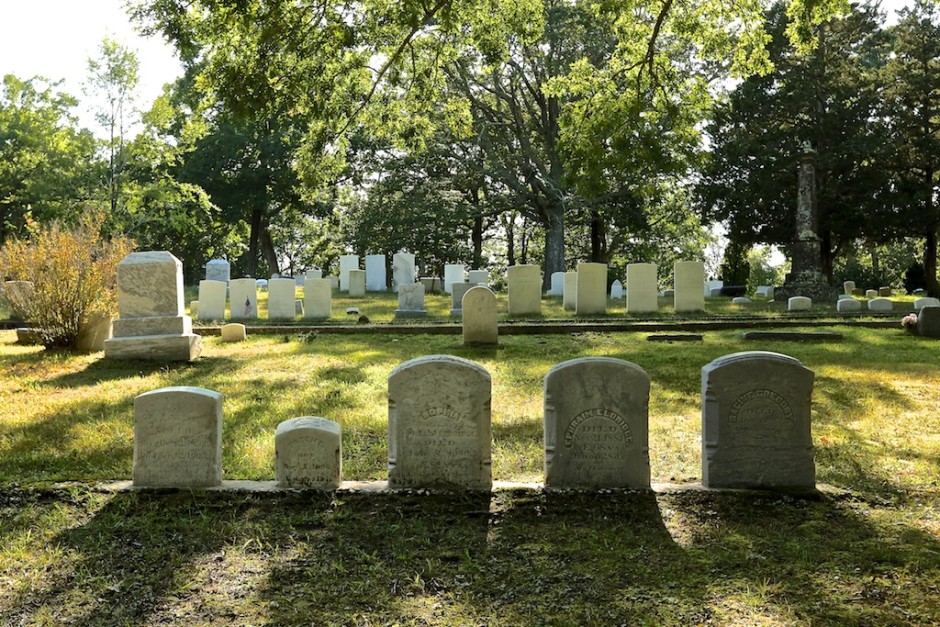
Oakland Cemetery & “Broken Mast Monument,” Opened in 1840.
Opened in 1840, the 10-acre Oakland Cemetery is adjacent the Ephraim Byram House (1852) and contains the gravesites of many notable Sag Harborites including summer resident and ballet master George Balanchine. Among its many impressive monuments and obelisks is the so-called Broken Mast Monument erected in the memory of whaling ships’ captains lost at sea “in actual encounter with monsters of the deep.” — Historic Division, Southampton Town Clerk
Historic Division, Southampton Town Clerk
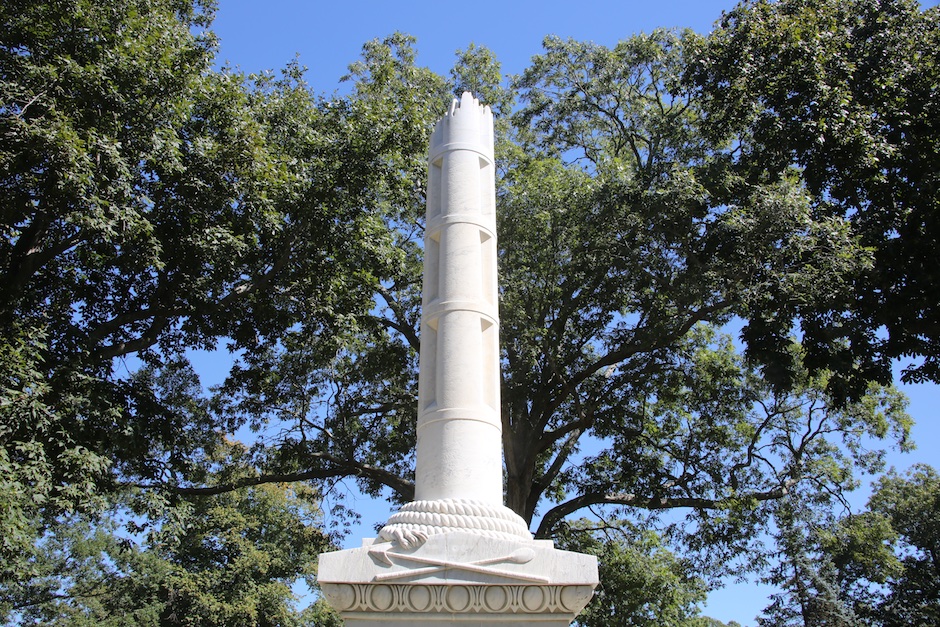


TO COMMEMORATE
THAT NOBLE ENTERPRISE
THE WHALE FISHERY
AND A TRIBUTE OF LASTING RESPECT
TO THOSE BOLD AND ENTERPRISING SHIP MAST
SONS OF SOUTHAMPTON
WHO PERILED THEIR LIVES
IN A DARING PROFESSION
AND PERISHED IN ACTUAL ENCOUNTER
WITH THE MONSTERS OF THE DEEP.
Entombed in the Ocean. They live in our memory.
—————————
Broken Mast Monument sculpted by Robert Eberhart Launitz in 1856 (called the “father of monumental art in America”). — Research by Jean Held, Sag Harbor Historical Society.
______________________________________________
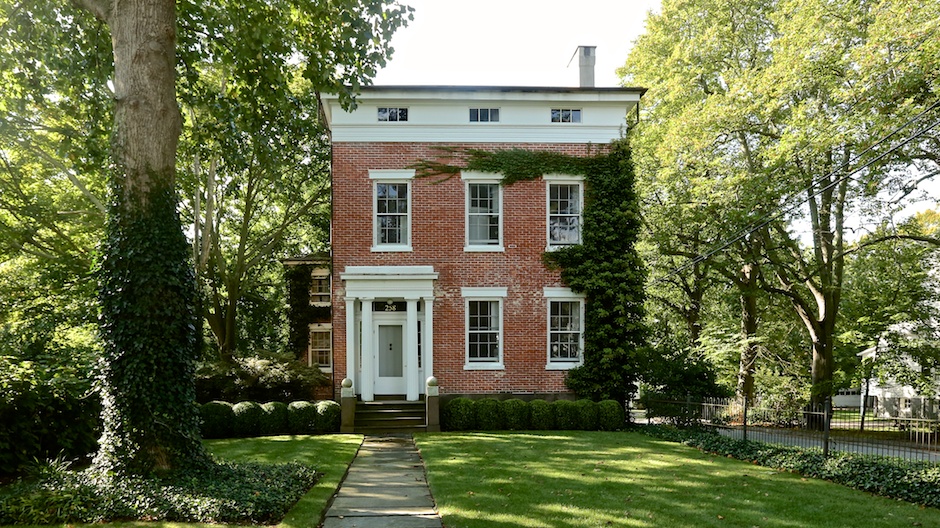
L’Hommedieu House, c. 1840, Sag Harbor
Closely resembling a New York City residence, this detached townhouse looks like it belongs in an urban context. The L’Hommedieus were involved in the West Indies trade. Samuel L’Hommedieu, grandson of a Huguenot fugitive, operated a ropewalk–a long, narrow building where workers walked back and forth twisting hemp into rope for use in ships’ riggings, lines and cables. — Society for the Preservation of Long Island Antiquities
______________________________________________

Stanton House, c. 1840, Sag Harbor
Standing at the division of Madison and Main Streets, the Stanton House was built in 1840 in the Greek Revival style. Its elaborate corner boards and denticulated cornice are typical, as is the front door surround. As a young midshipman, Admiral Stanton accompanied Commodore Matthew C. Perry’s fleet to Japan on one of his historic visits in 1852-4 that opened that reclusive nation to the West. Stanton was born in Sag Harbor in 1834 and died in Connecticut in 1924. — Historic Division, Southampton Town Clerk.
Historic Division, Southampton Town Clerk
______________________________________________
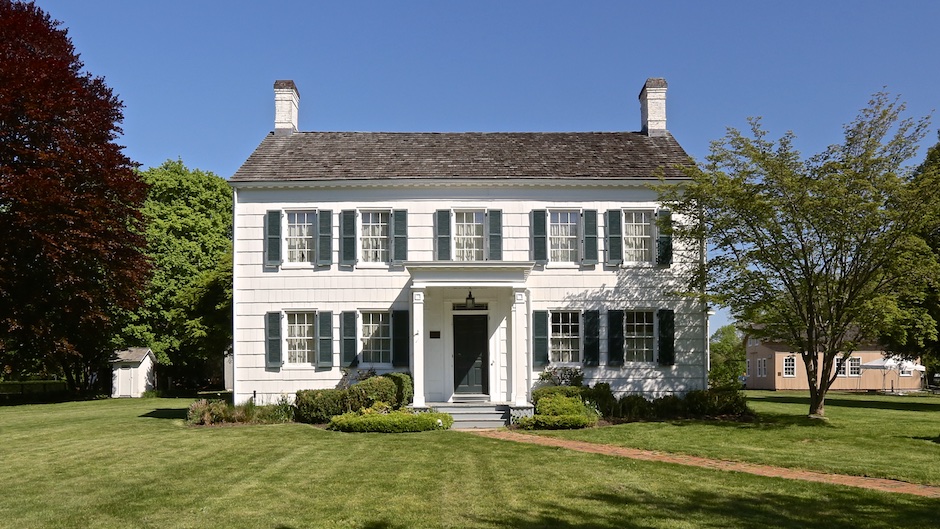
William Corwith House, ca. 1840, Bridgehampton
It is a vernacular five-bay Greek Revival-style house built by William Corwith ca. 1840; the house has two brick end chimneys, six-over-six-light wood window sash, and is clad in wood shingles. The house remained in the Corwith family until 1960, and soon after became home to the Bridgehampton Historical Society, which it remains today. Also on the property are the former Bridgehampton Jail, the Strong Blacksmith and Wheelwright Shop, and multiple barns and outbuildings that were moved to the site in the late 20th century. — Town of Southampton.
In 1877 a brochure was compiled and distributed by the Long Island Rail Road called “Long Island and Where to Go”. The brochure contained information about the train schedules, rates, destinations, sports, church denominations as well as hotels and boarding houses within 5 miles of the depot in each town on the island.
The pages on Bridgehampton include the number of trains a day (2), the rates (single fare, $2.40, excursion, $4.35), comments on the beach and pond, the Library, founded just the year before, in 1876, and a list of 35 places to board.
Since there were no hotels in Bridgehampton residents opened their houses to summer boarders. The list for Bridgehampton included the house of William A. Corwith and notes he could accommodate 15 boarders. Mr. and Mrs. Corwith had three daughters and there were probably 2-3 live in servants. Therefore, there were 22-23 people sleeping and eating in the Corwith House in the summer!
In the early 1880s, Mr. Corwith saw he could augment his income even more by taking in more summer boarders, so he enlarged his house. (Many other families did the same thing at this time. James A. Rogers is listed as taking in 30 boarders!). Mr. Corwith added a large dining room and several bedrooms on the second floor. The boarders rented the larger family bedrooms, and the family moved to the new small bedrooms in the back. Boarders and family had to double up, 3 or 4 or more to a room. — Bridgehampton Historical Museum.
www.bridgehamptonhistoricalsociety.org
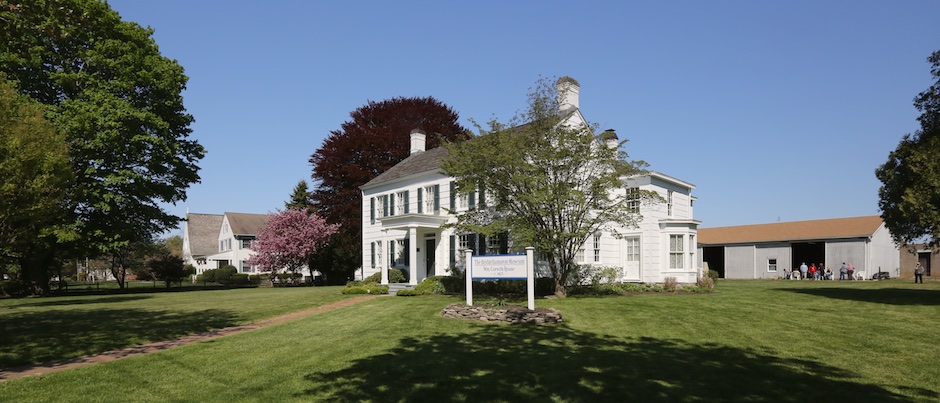
______________________________________________
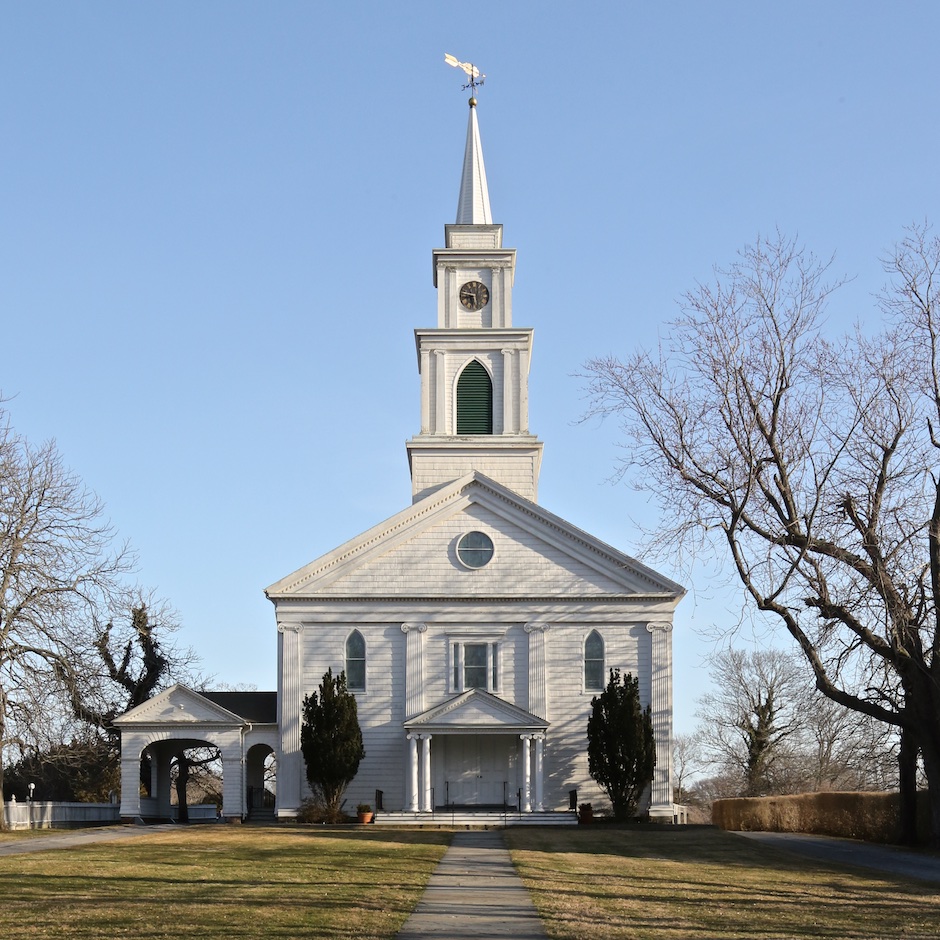
Bridgehampton Presbyterian Church, 1842
The Bridgehampton Presbyterian Church was most likely designed by Nathaniel Rogers, in the Greek Revival style. The clapboard-clad building features Ionic pilasters, pointed-arch windows, and the original spire. A port-cochere on the east side, a porch on the north side, and a clock were late 19th century additions. — Historic Division, Southampton Town Clerk.
Historic Division, Southampton Town Clerk
______________________________________________
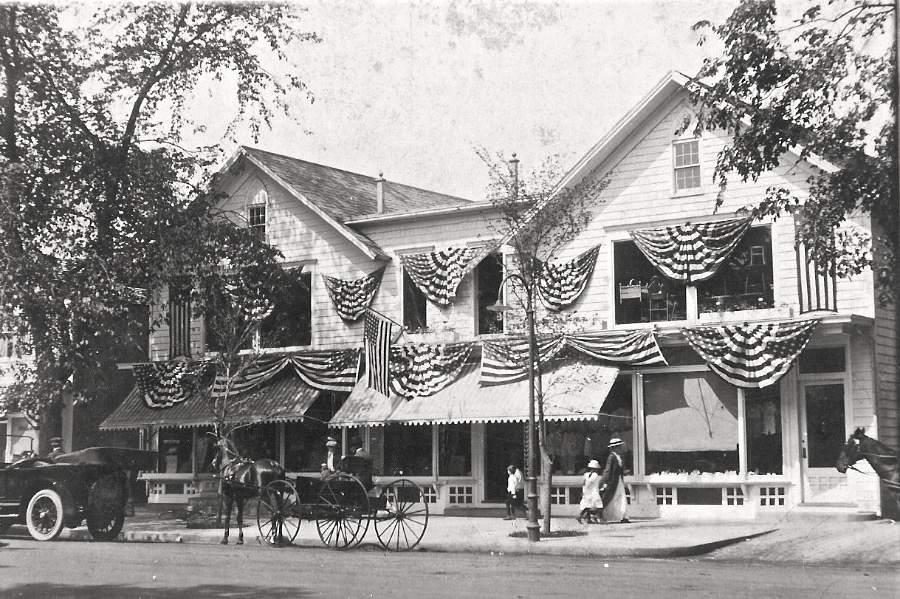
Hildreth’s Department Store, Southampton. Archival photograph courtesy of the Southampton Historical Museum.
In business since 1842 and now in its 13th generation of family ownership, the legendary
Hildreth’s Department Store now occupies two adjoining vernacular, gable roofed storefronts dating from the mid-19th century. A 2-story connector joins the two original buildings, one of which preserves cast iron columns on the main floor. Early maps identify the site as “L. Hildreth” in 1858 and “Mrs. A. Hildreth” in 1873. The business continues as one of the East End’s largest interior furnishings stores. — Southampton Historical Museum.
www.southamptonhistoricalmuseum.org
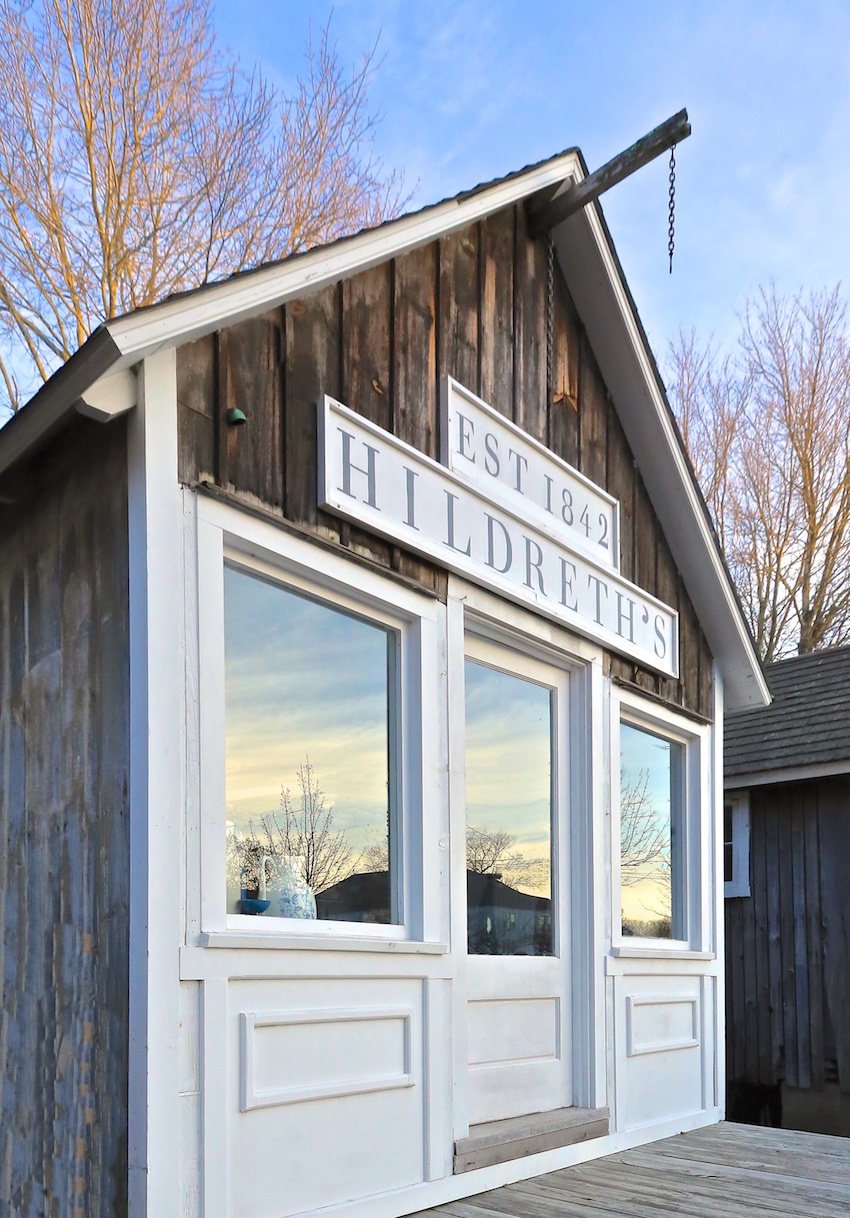
Hildreth’s Store, 1842, Southampton Historical Museum
www.southamptonhistoricalmuseum.org
AAQ Landmark: Rogers Mansion Museum
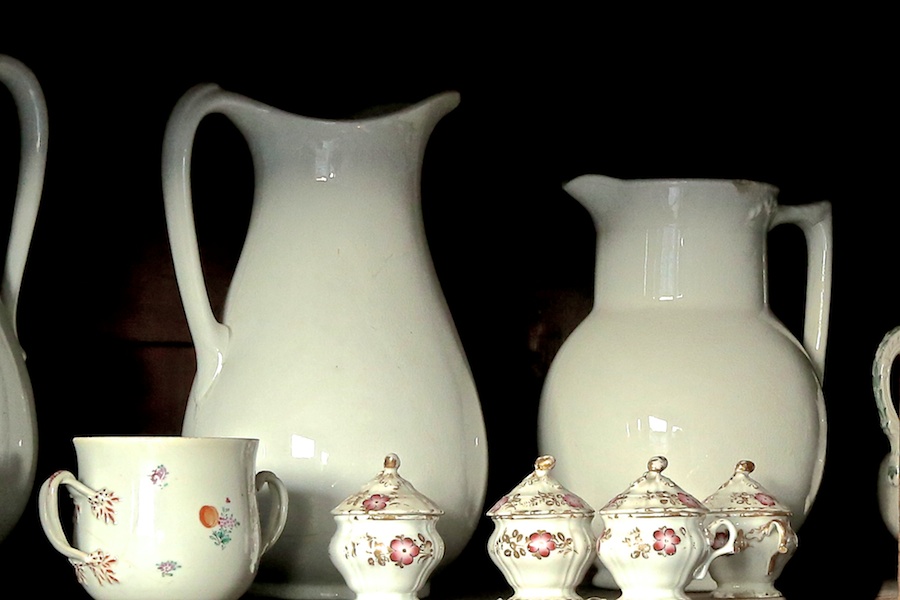
————————————————
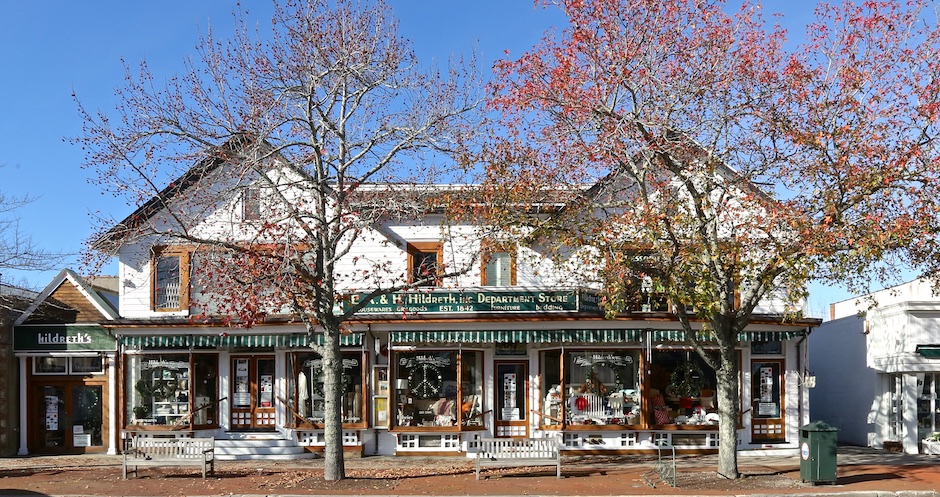
Hildreth’s Department Store, Main Street, Southampton. November 15, 2015.
______________________________________________
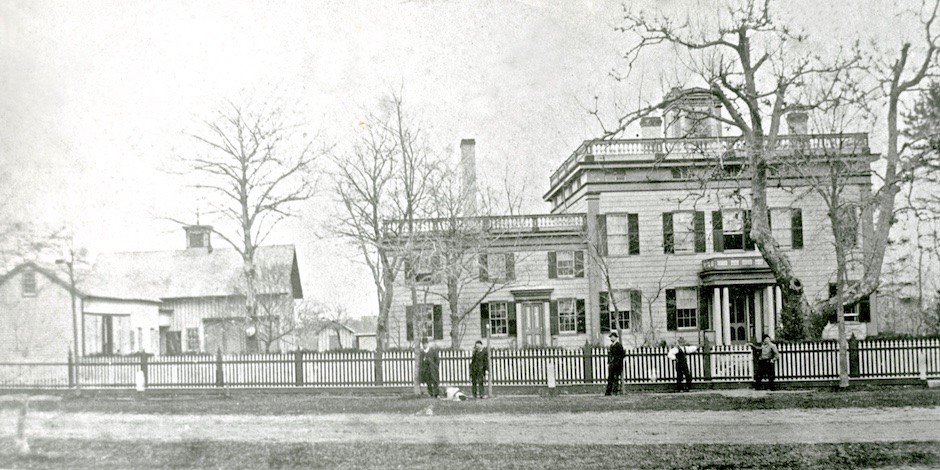
Abraham Topping Rose House, 1843, Bridgehampton.
The house of Abraham Topping Rose (1792–1857) was built in 1843 on the existing foundation of an 18th-century home and tavern that he inherited from his father, Dr. Samuel H. Rose (1761–1832), a Revolutionary War surgeon. — Julie B. Greene, Bridgehampton, Images of America / Arcadia Publishing.
AAQ / Resource / Education, Books — Click Here.

Topping Rose House, 2014. Araiys Design, landscape architects.
Visit AAQ Resource / Landscape Architect — Araiys Design
______________________________________________
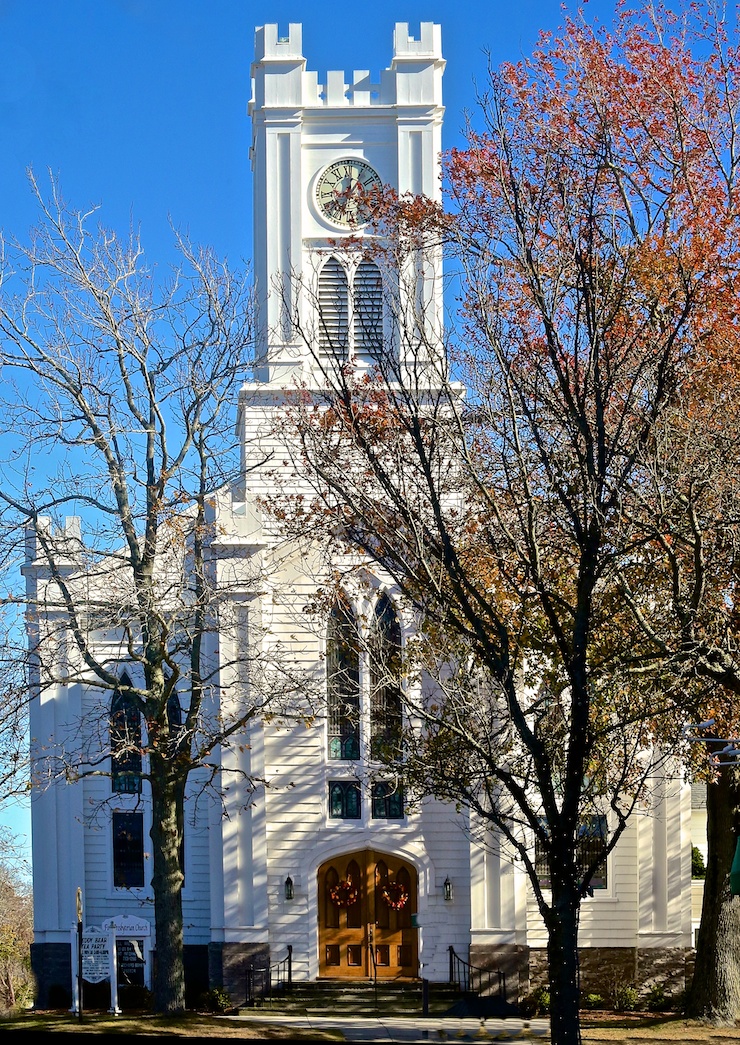
First Presbyterian Church, 1843, Southampton
“The Congregation of this church was ‘gathered and constituted according to the mind of Christe’ in the spring of 1640. The first church was a rude thatched building which also served for court and town meetings, and was located about one mile east of this spot. Successor church structures were build in various locations on ‘Ye Main Street’ in 1653 and 1707. This House of Worship was erected in 1843, with roots in the reformed tradition and distinguished ‘by name of stile of Presbiterians’ as early as 1707. This is considered by some historians to be the oldest Presbyterian Congregation in America.” — Plaque on site.
______________________________________________
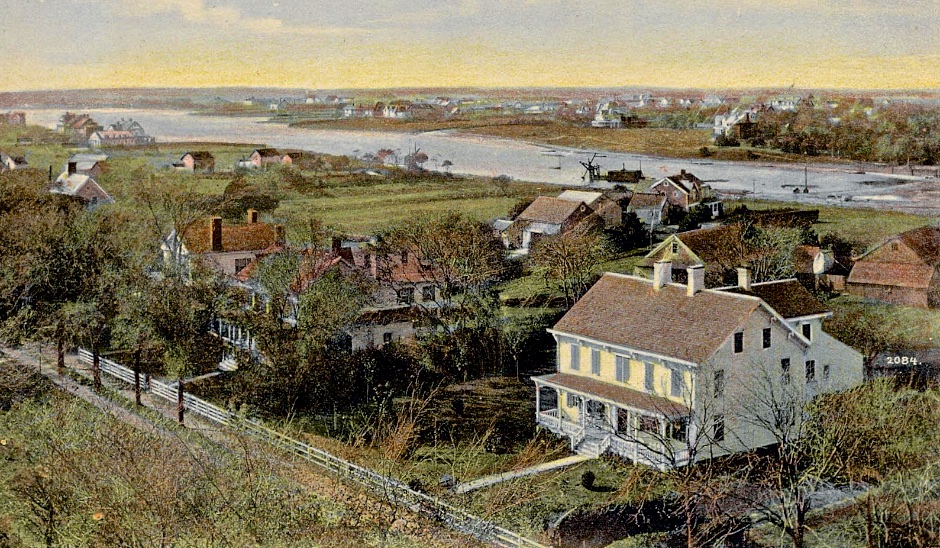
Bird’s eye view of Lake Agawam. Archival postcard courtesy of the Southampton Historical Museum.
______________________________________________
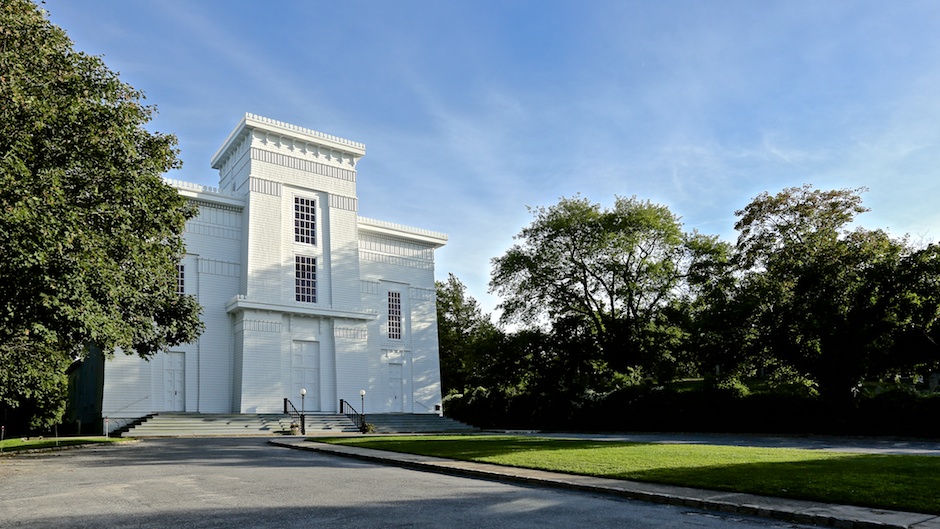
Whalers’ Church, c. 1843, Sag Harbor. Minard Lafever, architect.
Built in 1843-44, this church was erected as a monument to the town’s whaling prosperity. Designed by noted architect Minard Lafever, the exterior is the best example of the Egyptian Revival style in the United States today, and its decoration includes a blubber-spade motif along the roofline. Originally, the church was topped with a 185-foot steeple visible to ships rounding Montauk Point as a welcoming beacon. The steeple was lifted off intact by the 1938 hurricane and smashed into the Old Burying Ground. It was never rebuilt. — Sag Harbor Historical Society
AAQ / Landmark — Old Whalers Church, 1843
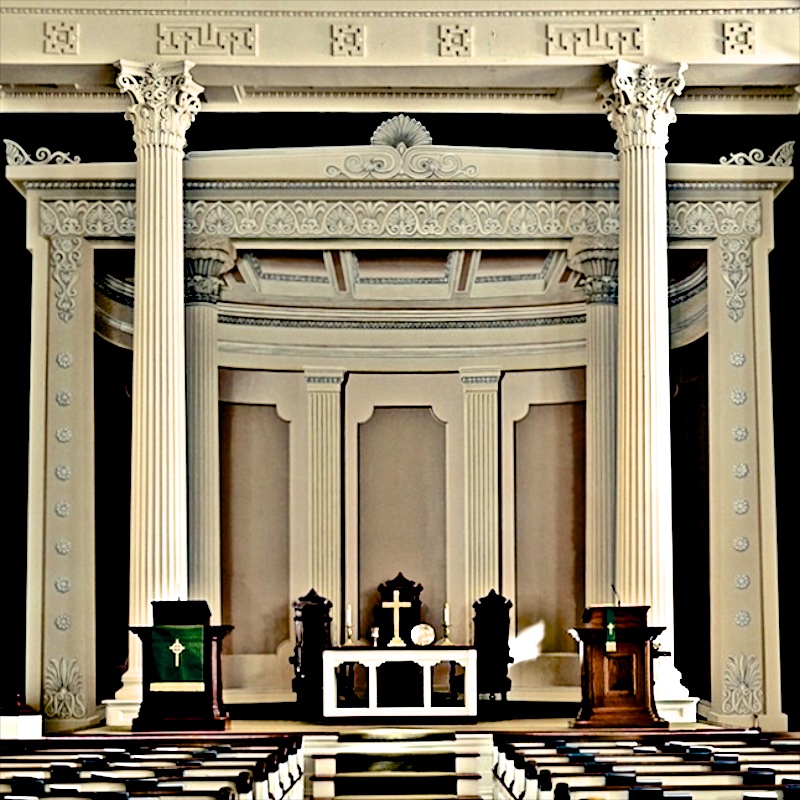
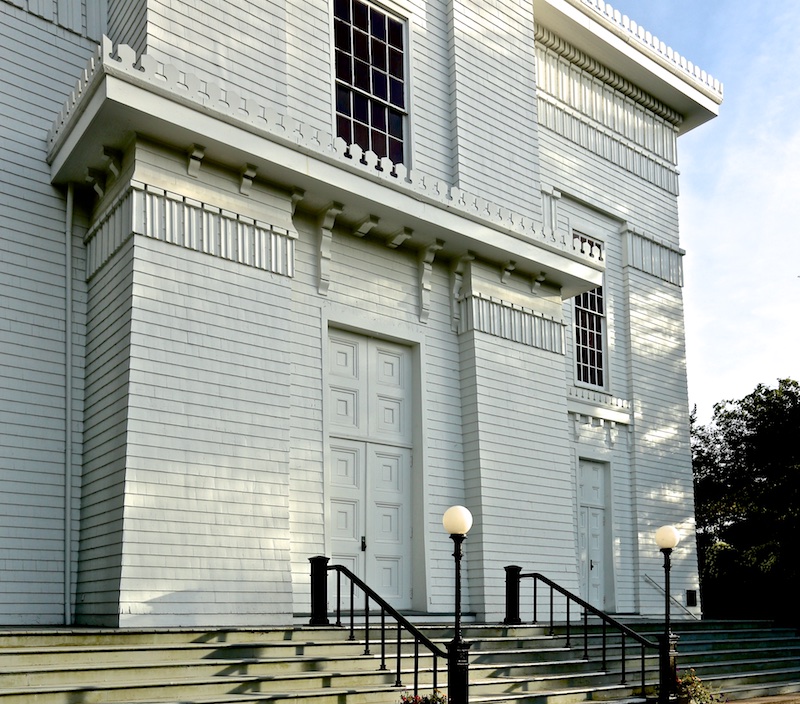
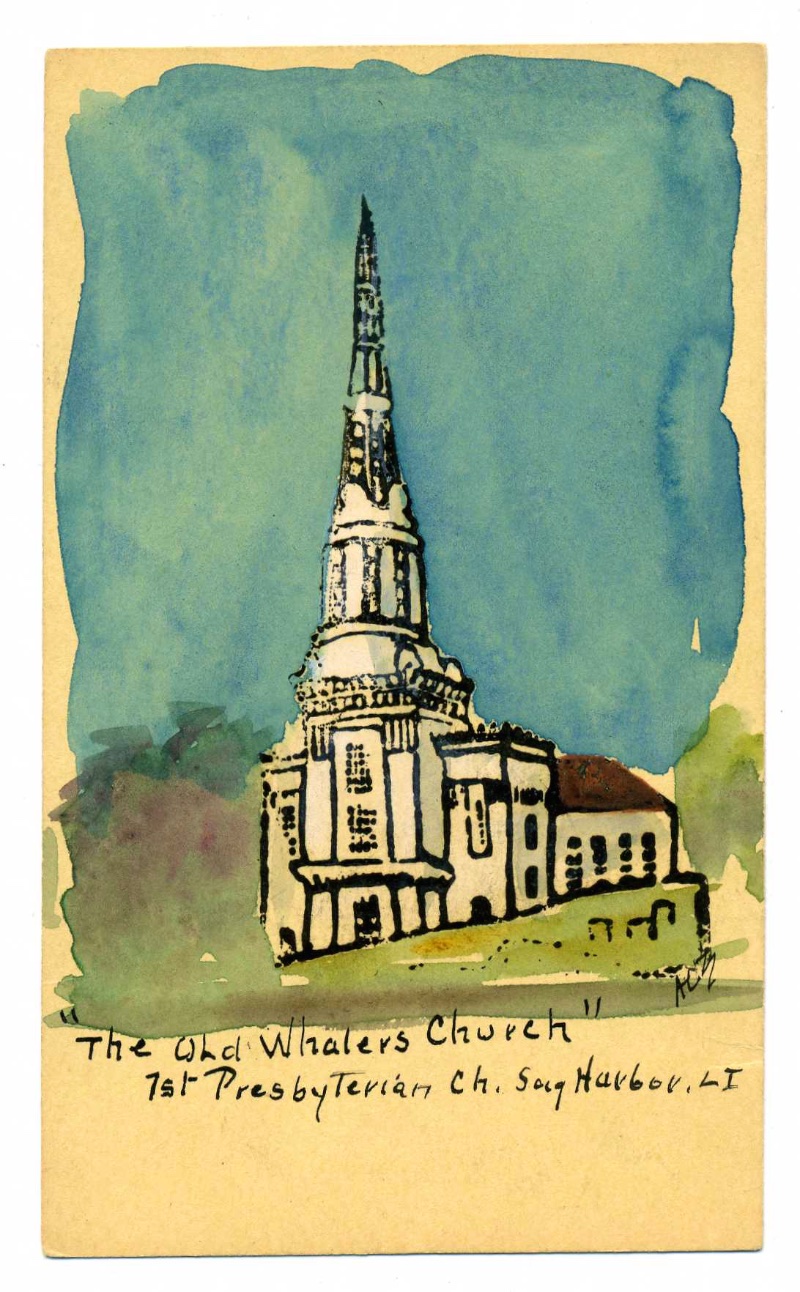
Archival postcard courtesy of Eric Woodward.
———————————
The steeple of the Whalers Church was blown down in the great hurricane of 1938. Mr. Cleveland, the sexton of the church at the time, described the spectacular scene to Berton Rouche, who wrote a well-known piece called “The Steeple” for The New Yorker of March 5, 1949:
“September 21, 1938, at 3:30 in the afternoon, was the date. Well, see the new-looking concrete in the walk there, alongside the burying ground wall? That’s where the butt of the steeple hit. I live just the other side of the burying ground, and I was looking out the window and I saw it go. What happened was the wind caught under the louvers in the Sir Christopher Wren section. It lifted the whole shebang straight up in the air–the whole 150 or more feet of it–swung it clear of the building, and dropped it on the walk there. Then it toppled over into the burying ground and smashed to smithereens. All except the bell. That didn’t get a scratch on it.”
— Guide to Sag Harbor: Landmarks, Homes & History by Henry Weisburg & Lisa Dennison, 1975.
______________________________________________
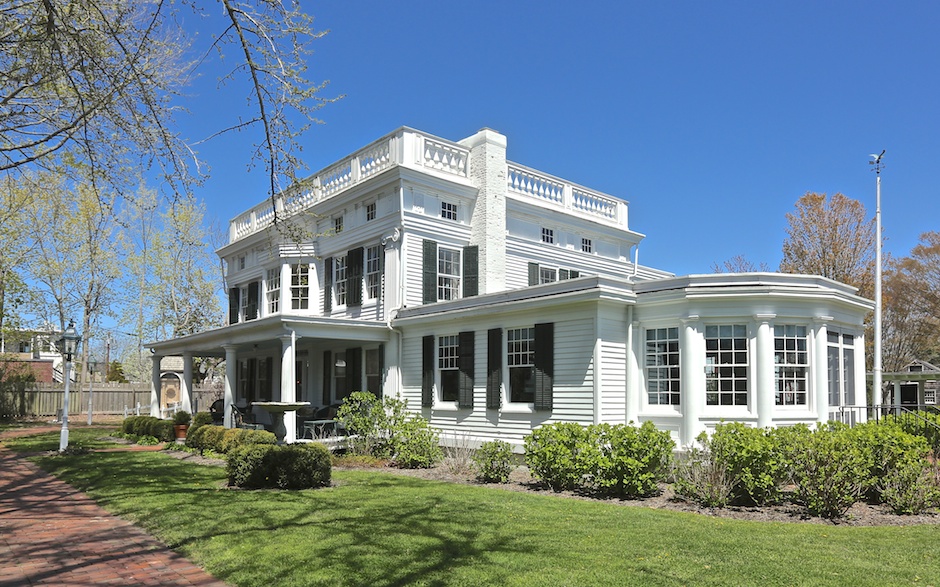
Rogers Mansion, 1750 to 1926, Southampton. Greek-revival style added by Captain Albert Rogers in1843.
William Rogers purchased the property in 1648 and was owned by a Rogers descendent until 1880. The most prominent family member was whaling Captain Albert Rogers who, in 1843, added a Greek-revival style addition onto an earlier farm house. The Captain had become newly rich, like many other Southampton businessmen in the flourishing whaling industry which came to a sudden halt in 1847 due to the decimated whale population and over production of whale products. The classical style façade has Doric columns on the porch, an ornamental balustrade, and a belvedere (or widow’s walk). This type of house can be seen throughout the Hamptons and were almost always built from fortunes made in whaling.
After a brief tenure by the Nugent family, Samuel L. Parrish purchased the property in 1899 and quickly added to the structure in the Colonial Revival style. Mr. Parrish, a very successful New York City attorney, was one of the first of Southampton’s summer colonists who began spending summers in Southampton in the 1880s to escape the heat of the City. The Mansion contains period rooms, an extensive toy collection, and temporary exhibits on local history and culture. Stanford White designed many of the renovations made in the early 20th century. The Research Center has books, manuscripts, maps and photographs on the history of Southampton. On the grounds are eleven historic structures including a one-room schoolhouse, a 19th century paint shore, a decoy carver’s workshop and the 1739 Sayre Barn. — Southampton Historical Museum.
www.southamptonhistoricalmuseum.org
Visit: AAQ / Landmark — Rogers Mansion, 1750 / 1926
———————-
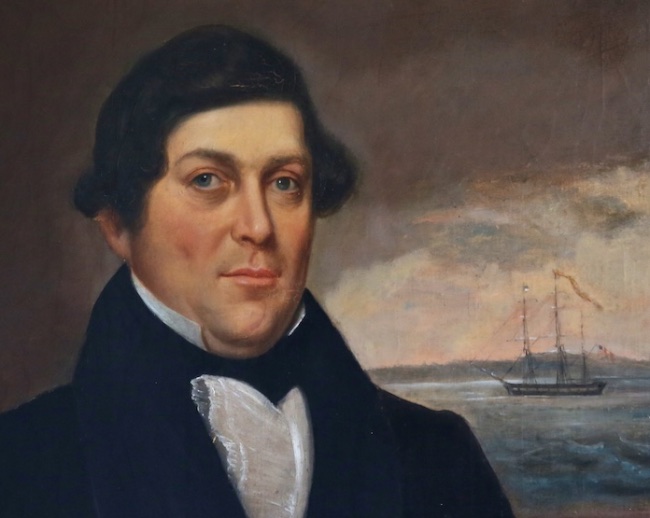
Captain Albert Rogers was born on January 10, 1807, at the Rogers’ Southampton home. At the age of 20 he became the sixth generation of his family to own and live on the land originally allotted to William Rogers in 1648. In 1843, Captain Rogers was wealthy enough to build a house worthy of the successful whaling captain he was. He chose the popular Greek-Revival style for the Rogers Mansion, a testimony to his refined tastes and local prestige. When gold was discovered in California in 1849, Captain Rogers and other whaling captains from Southampton formed the Southampton California Mining and Trading Company and joined the Gold Rush. — Southampton Historical Museum’s “If These Walls Could Talk,” current exhibit.
Visit current exhibit at the Southampton Historical Museum: If These Walls Could Talk (Click Here)

Holiday Exhibit, 2014, Rogers Mansion.
______________________________________________
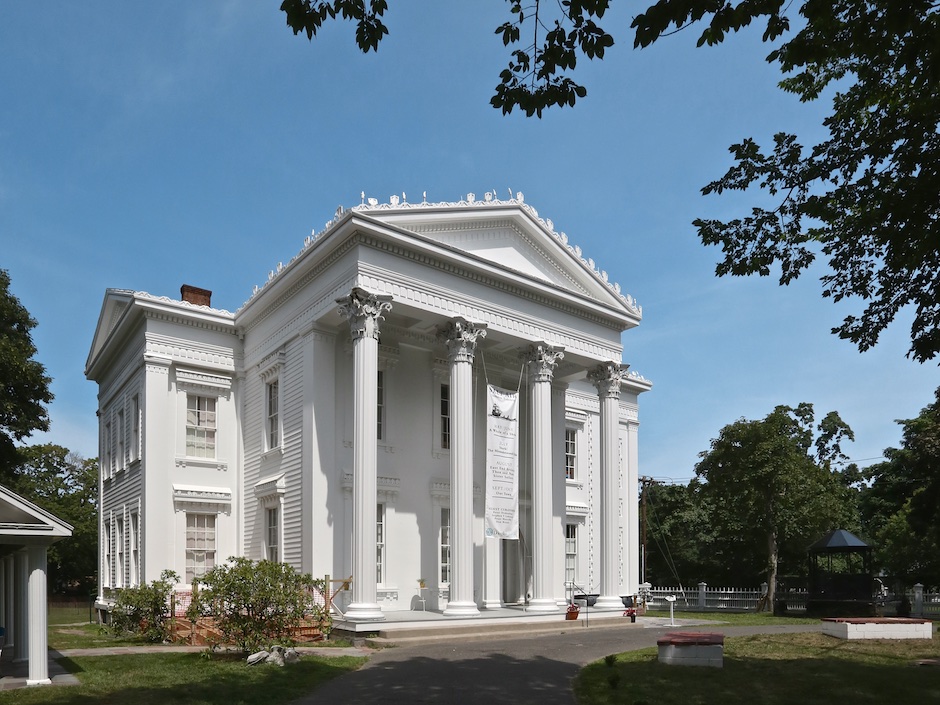
Benjamin Huntting House, c. 1845. / Old Whalers Museum. Minard Lafever, architect.
Benjamin Huntting II hired architect Minard Lafever, who designed the Old Whaler’s Church, to design a classic, Greek temple-front mansion. It later became the summer home of Mrs. Russell Sage, and the Whaling Museum in 1936. As more than one text states, “a monument to the self-confidence of the successful whaler,” with its temple-front portico and fluted Corinthian columns, its blubber-spade decoration along the roofline and whale jawbones framing the front door. The interior has been renovated and is open to the public as a museum for whaling artifacts and paraphernalia, including a whaleboat in the front yard. It is Long Island’s finest example of Greek Revival architecture. — Historic Division, Southampton Town Clerk.
www.sagharborwhalingmuseum.org

______________________________________________
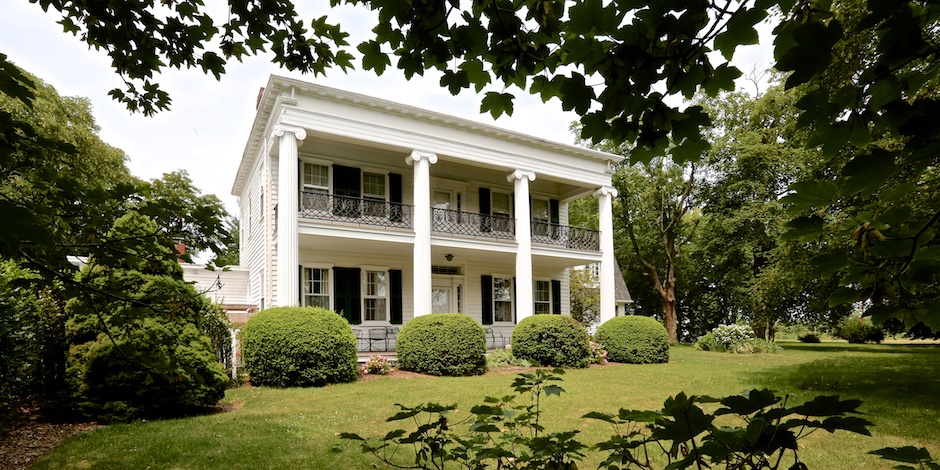
Rogers House, ca. 1845, Hayground
Nathaniel Rogers was born on this site in an earlier house belonging to John T. Rogers; Rogers graves are abundant in the cemetery and the second Hay Ground School building (ca. 1830) has been on the Rogers Farm since 1891 when James Rogers bought and moved it. This 5-bay Greek Revival, with imposing Ionic columns, corresponds understandably to Bridgehampton’s Nathaniel Rogers House of the same vintage. — Town of Southampton.
______________________________________________
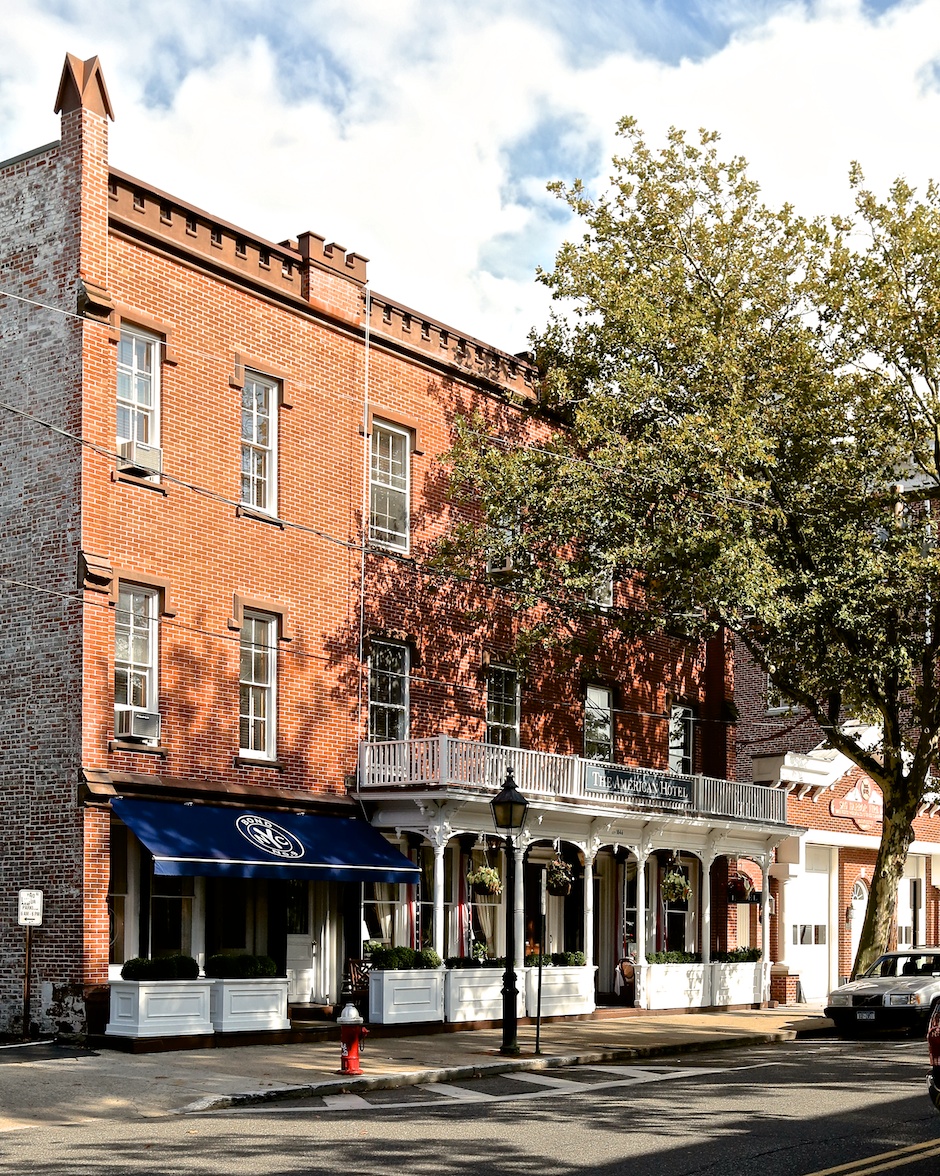
American Hotel, 1845, Sag Harbor
The hotel was rebuilt by cabinetmaker Nathaniel Tinker for his business premises after the fire of 1845. The site is thought to be that of the earliest residence in Sag Harbor, James Howell’s Inn, where Lieut. Col. Jonathan Meigs captured British officers in their beds during the Revolutionary War. The porch, with its columns in the Gothic Revival style, was added across the front when the building was converted to a hotel in 1877. — Sag Harbor Historical Society.
______________________________________________
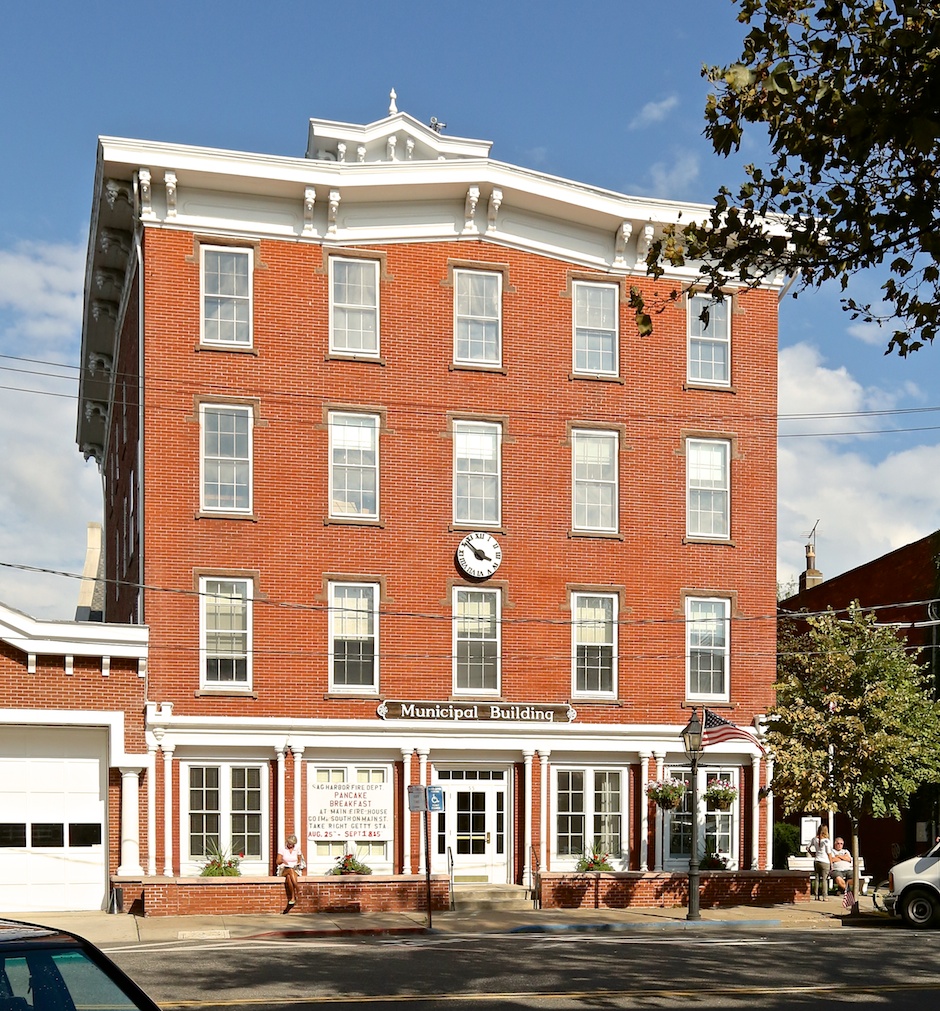
Sag Harbor Municipal Building, c. 1846, Sag Harbor
Next door to the American Hotel is Sag Harbor’s Municipal Building, formerly the Mansion House Hotel. In 1873 the hotel was converted for use as Sag Harbor’s first comprehensive Union School. It functioned as a school until 1907, when philanthropist and summer resident Mrs. Russell Sage decided that a more modern school was needed. Pierson High School was built with her money the following year. — Historic Division, Southampton Town Clerk.
Historic Division, Southampton Town Clerk
______________________________________________
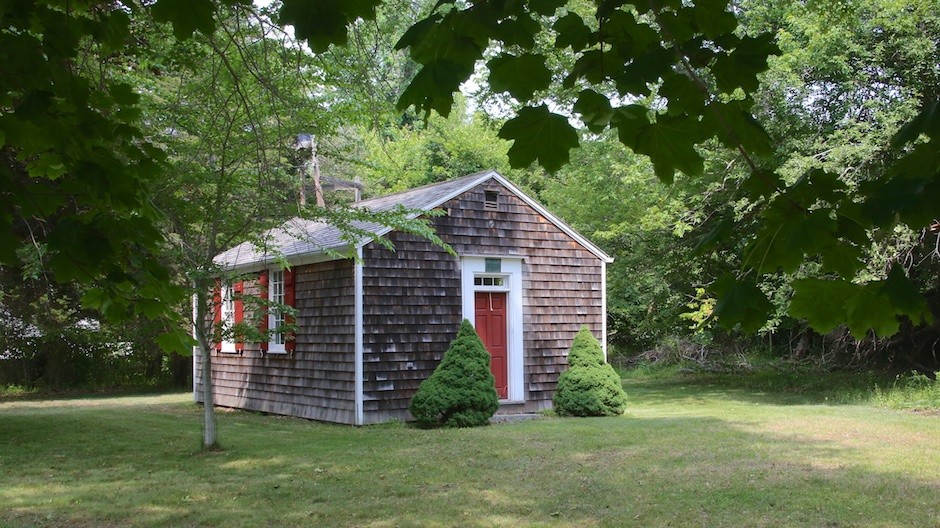
One-Room Schoolhouse, c. 1847, North Haven
Built about 1847, it replaced an earlier structure located closer to the water’s edge that was swept away in a storm. By 1891, a decision was made to replace the building with a two-room version and the old schoolhouse was moved nearby and repurposed as a wood shed which it remained for many years. But after the formation of the North Haven Village Improvement Society in 1932, the modest but now venerable building was again recycled–this time as Village Hall–and moved once again, back to its original location at the corner of Payne Avenue and Ferry Road. — Historic Division, Southampton Town Clerk
Historic Division, Southampton Town Clerk
______________________________________________
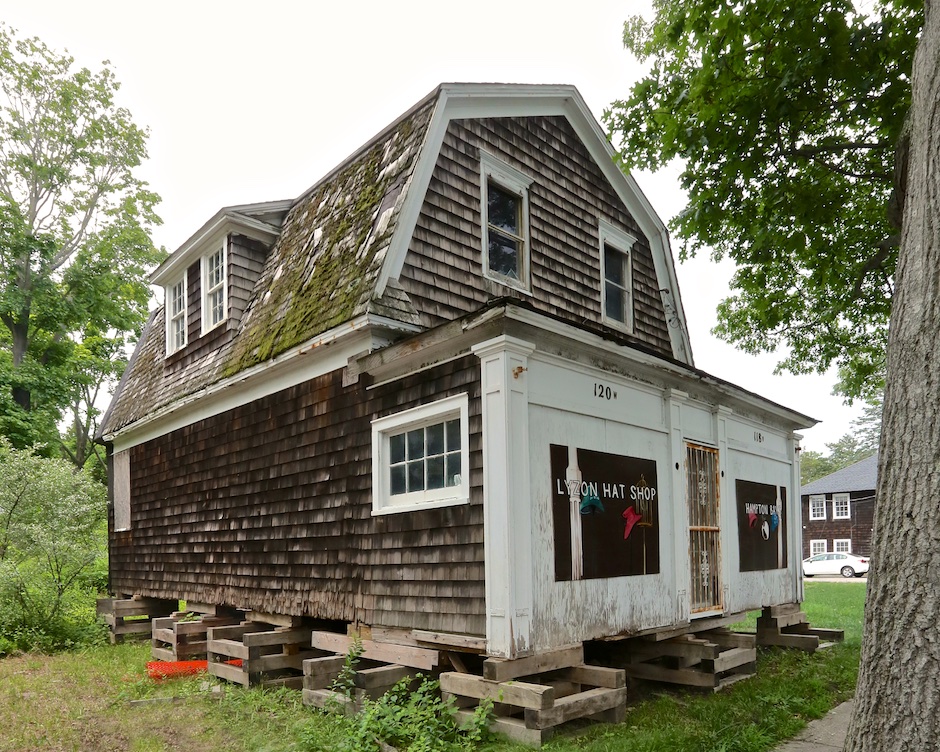
Lyzon Hat Shop, 1850, Hampton Bays
The Lyzon Hat Shop is a gambrel-roofed frame structure purported to date to 1850. The structure originally served as a general store operated by Elisha King. A fire partly destroyed the house in 1910, and it was rebuilt by Elisha’s son, Walter Howard King, who collaborated with his wife to begin a successful hat business, Lyzon Hats, operating out of the structure. — Town of Southampton.
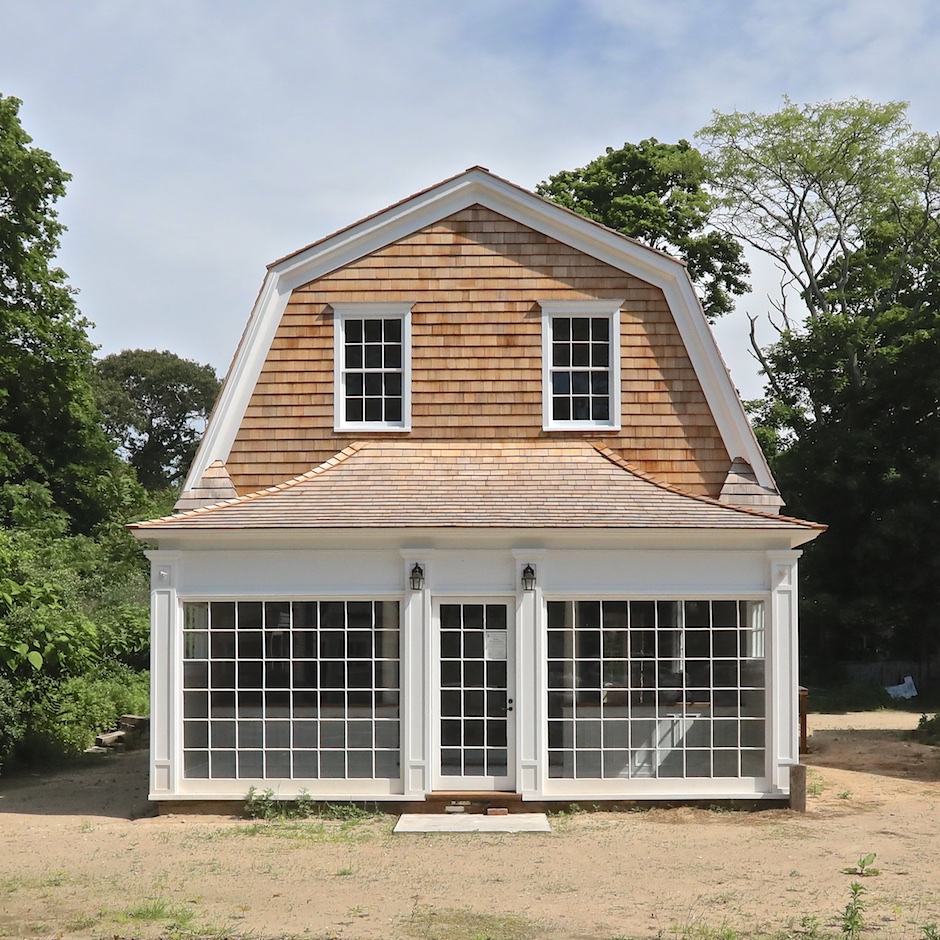
June 8, 2017
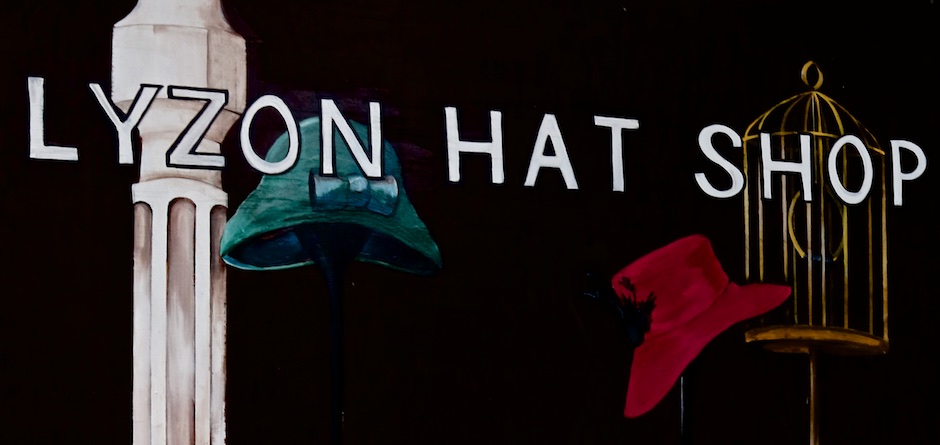
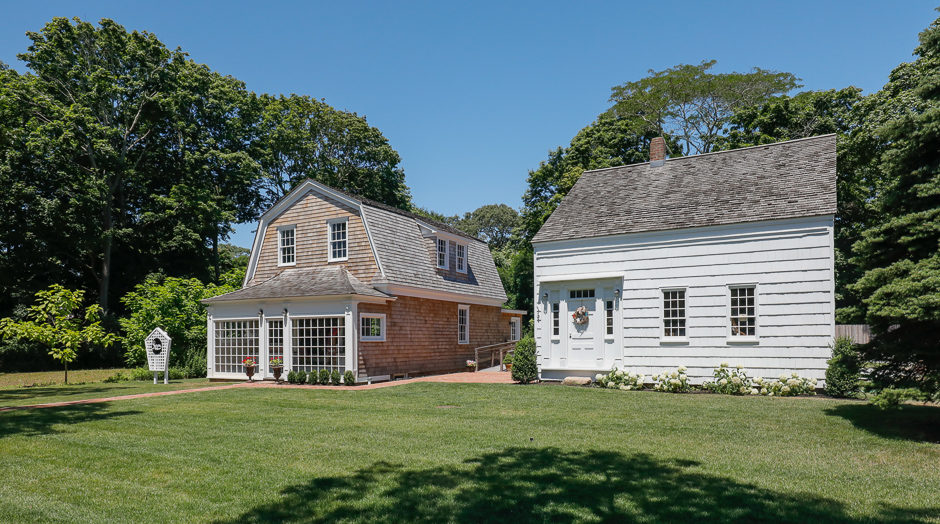

Prosper King House (right), circa 1790, and Lyzon Hat Shop, circa 1850. A Main Street Historic Restoration and Landmark Site, Hampton Bays. Stewards: The Hampton Bays Historical & Preservation Society.
Photo / July 2018.
______________________________________________
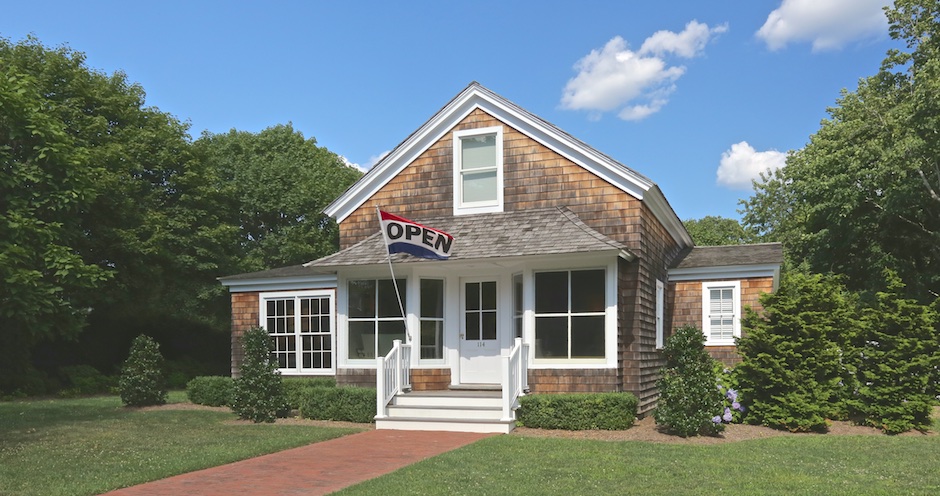
The Pond House, 1850. Home of the Quogue Historical Society.
This was Mary Payne’s “Home Store,” where Mrs. Payne sold school supplies, notions, bric-a-brac, and penny candies from the two front rooms beginning in the 1920s. — Quogue Historical Society.
______________________________________________
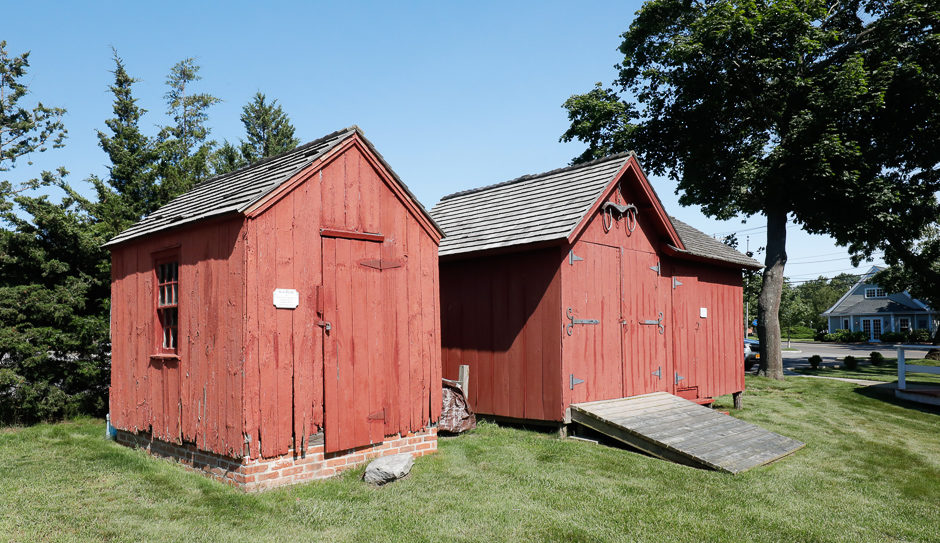
Foster – Meeker Carriage House and Privy, Circa 1850. Milk House from Thurston Raynor’s Apaucuck Farm, founded circa 1775.
______________________________________________

The Blue Barn, a two-story barn with a front-gable roof and simple, symmetrical massing, is currently designated as a Town of Southampton Landmark. Its front façade is dominated by its large doors, only one of which is original and features cross bracing. The barn is painted blue with white trim. The mid-19th century barn was on the property of the Havens House Hotel, a popular turn-of-the-century destination for summer visitors. The Havens House was destroyed by fire in 1924, but the barn survives. — Town of Southampton.
Town of Southampton Landmark
______________________________________________
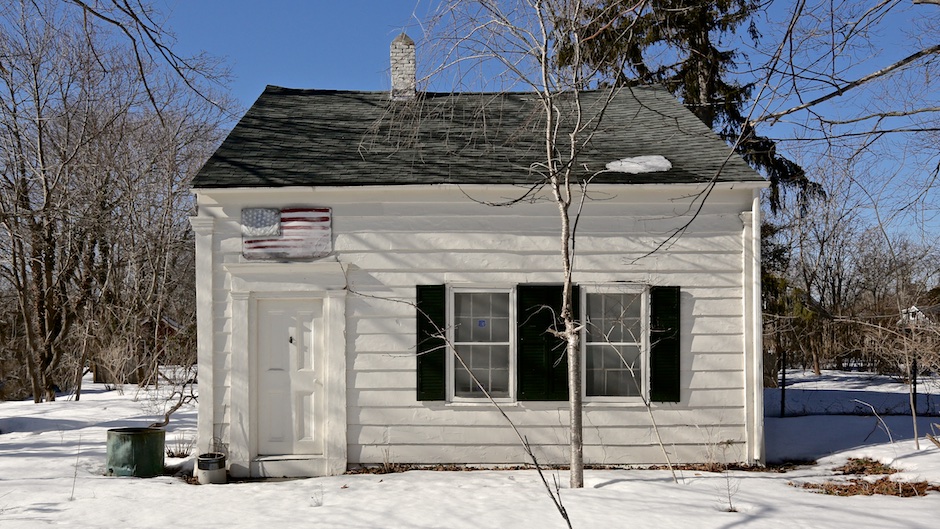
William Edwards House, 1851, East Quogue. Built for his Bride, Caroline R. Phillips.
This single-story three-bay vernacular house is an exceptionally well-preserved example of a Greek Revival-style cottage. Its entryway is framed by pilasters and an entablature and contains a four-panel wood door. Windows throughout the small building contain six-over-six-light double-hung sash. The house is clad in wide wood clapboards. Pilasters are located at either end of the façade. — Town of Southampton.
______________________________________________
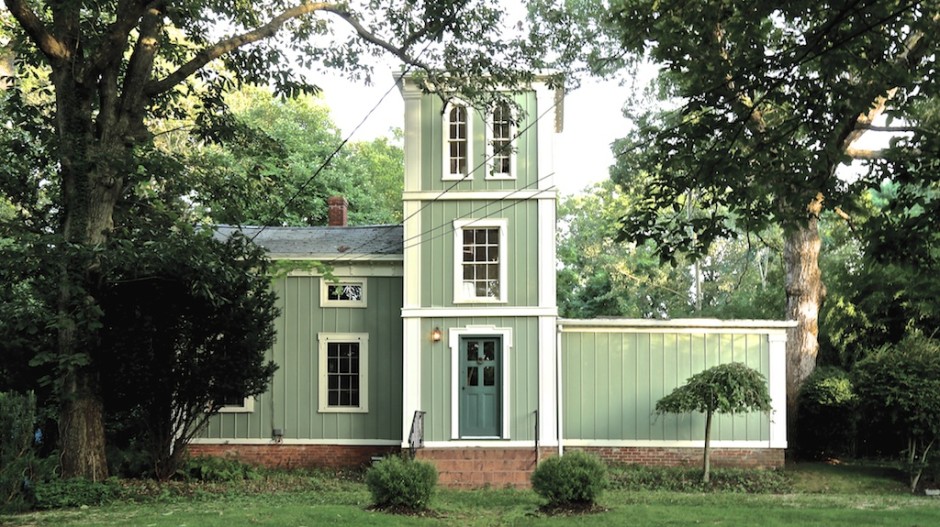
Byram House, Sag Harbor, c. 1852.
Sag Harbor’s eccentric inventor Ephraim Byram was born to a family of clockmakers and was himself a mechanic, astronomer, bookbinder and cabinetmaker in addition to a maker of clocks. His Italianate Revival style villa built c. 1852 stands in front of the site of the Sherry & Byram Clock Works, which produced large clocks for church steeples and street posts all along the East Coast. The asymmetrical tower of Byram’s house was not only fashionable but also provided the amateur astronomer with an observatory for viewing the heavens. — Historic Division, Southampton Town Clerk.
Historic Division, Southampton Town Clerk
______________________________________________

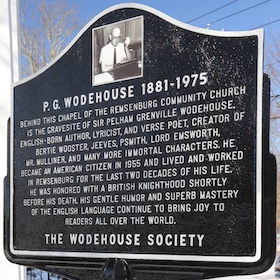
Remsenburg Presbyterian Church, 1853
The Remsenburg Presbyterian Church (also known as The Chapel or the Remsenburg Community Church) is a Greek Revival-style building, constructed in 1853. Its front-gable façade is distinguished by pilasters and a cornice and features a central doorway containing paneled double doors and is framed by pilasters and a frieze band. The doorway is flanked by two large windows, each containing sixteen-over-sixteen-light double hung sash (similar windows occupy the side facades). A small steeple containing a belfry surmounts the church; the steeple was likely replaced around the turn of the century. The church is clad in wood shingles and has a brick foundation. The Remsenburg Cemetery is located immediately to the rear of the church. The grave of author P.G. Wodehouse is located here. — Town of Southampton.
______________________________________________

Herrick Hardware, Southampton, 1858.
One of the village’s oldest commercial buildings, Herrick Hardware appears on historic maps
as “store and Post Office” in 1858, as “H.F. Herrick Store” by 1873 and as “Herrick” in 1902 and 1916. By 1932 it had become a hardware and paint store, as it is today. The two-story gable roofed structure with six-over-six windows is a vernacular building of the mid-19th century. — Southampton Historical Museum.
www.southamptonhistoricalmuseum.org
——————————————-
Demolished December 23, 1949
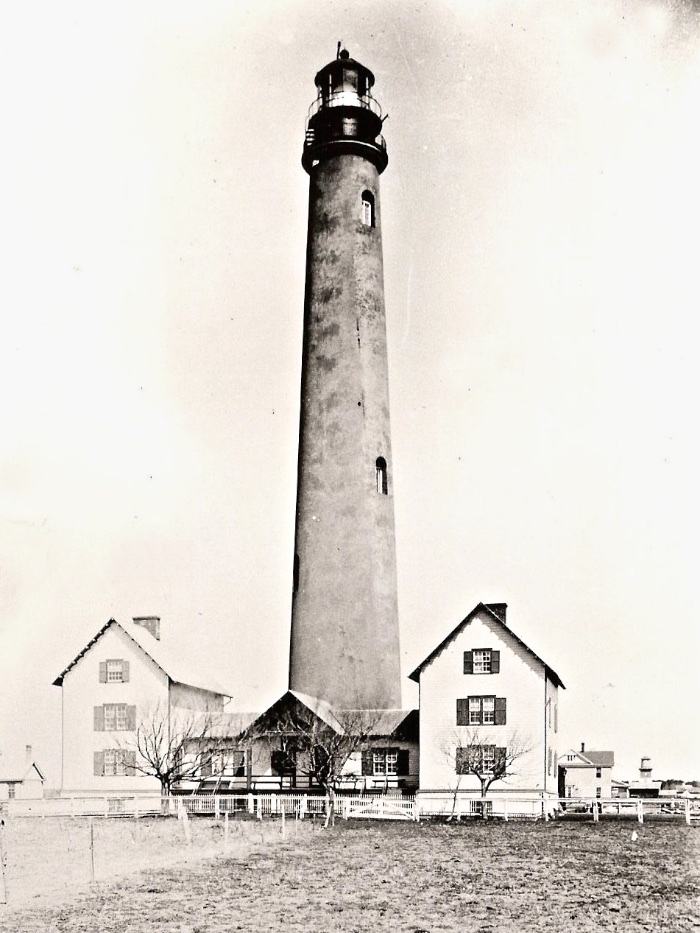
Ponquogue Lighthouse (sometimes called the Shinnecock Lighthouse), 1858, Hampton Bays
Until the lighthouse went into service on January 1, 1858, Montauk Lighthouse, erected in 1796, was the only one on eastern Long Island. Several shipwrecks in the years immediately following its inauguration were thought to have resulted from confusion over the change. In the days before ocean telegraphy, there was no way of communicating navigational alterations to crews at sea.
Taken out of service in 1931, the 170-foot Ponquogue Lighthouse was demolished on December 23, 1949, despite efforts of preservationists to save it.
— Mary Cummings, Southampton, Images of America / Arcadia Publishing. Photograph courtesy of the Southampton Historical Museum.
AAQ / Resource / Education, Books — Click Here.
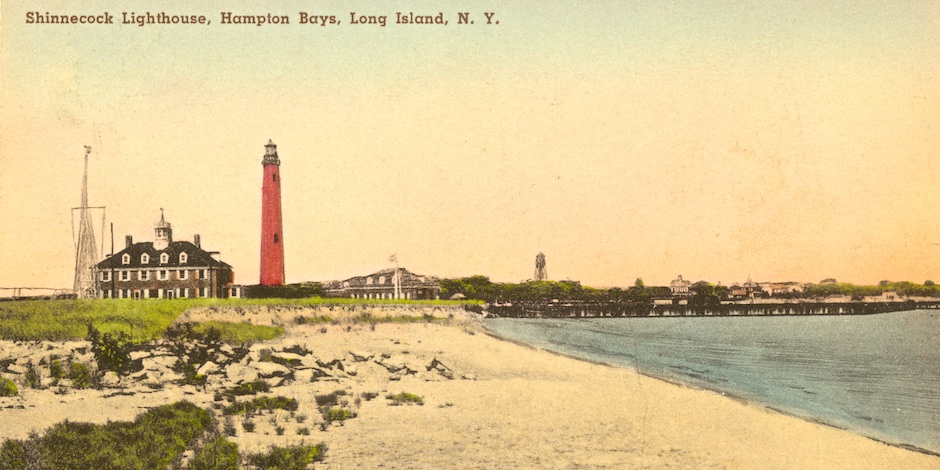
——————————————–
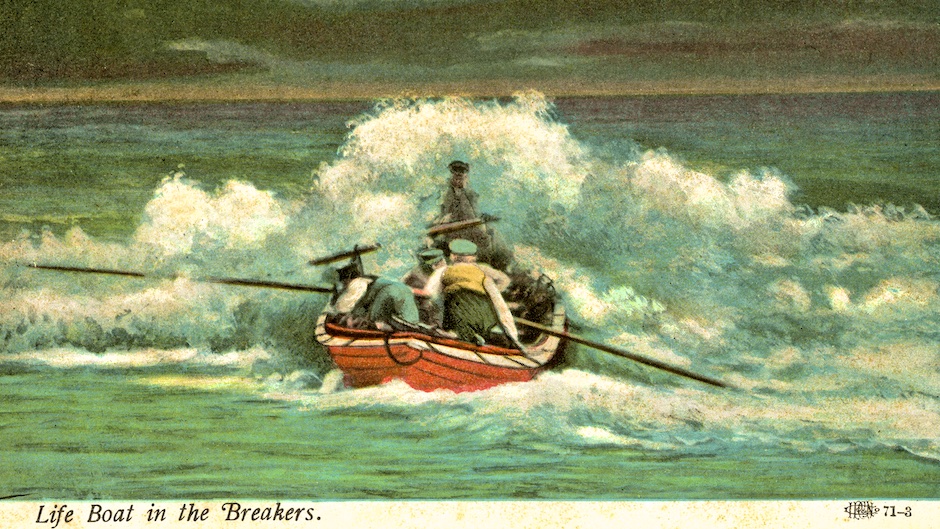
Archival postcards courtesy of the Southampton Historical Museum.
——————————————–

House, 1859, Water Mill
This house was reportedly built in 1859, and was moved and renovated later in the 19th century in the Queen Anne style. The house has a cross-gable roof, Queen Anne-style gable windows, and chamfered corners with decorative treatment. — Town of Southampton.
______________________________________________

Speonk River
______________________________________________
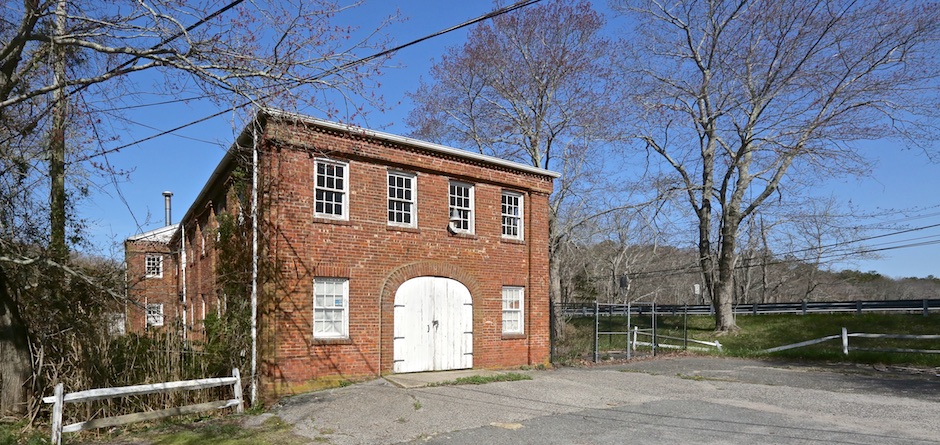
Fordham Mill, 1859, Speonk
The Fordham Mill (also known as the Tuttle-Fordham Mill) is currently designated as a Town Landmark and was previously documented as part of the Historic American Engineering Record. The two-story brick industrial building has a flat roof and a four-bay façade with a central arched doorway containing board-and-batten double doors. The structure’s design exhibits elements of the Greek Revival style. It has a dentilled cornice rendered in brick and pilasters at either end of the front façade and along the side elevations. The windows throughout the structure contain six-over-six-light double-hung wood sash. The mill was constructed in 1859. It was built by Daniel Tuttle to house his carriage manufacturing business, which he had established in 1844. The water-powered mill continued to be operated by members of the Tuttle family until it was sold to Everett O. Fordham ca. 1900. Fordham operated a lumber and millworking business in the mill until 1945, when the business was taken over by Wilbur Benjamin. The structure continued to operate as a lumber and millworking business until well into the late 20th century. — Town of Southampton.
Southampton Town Landmark
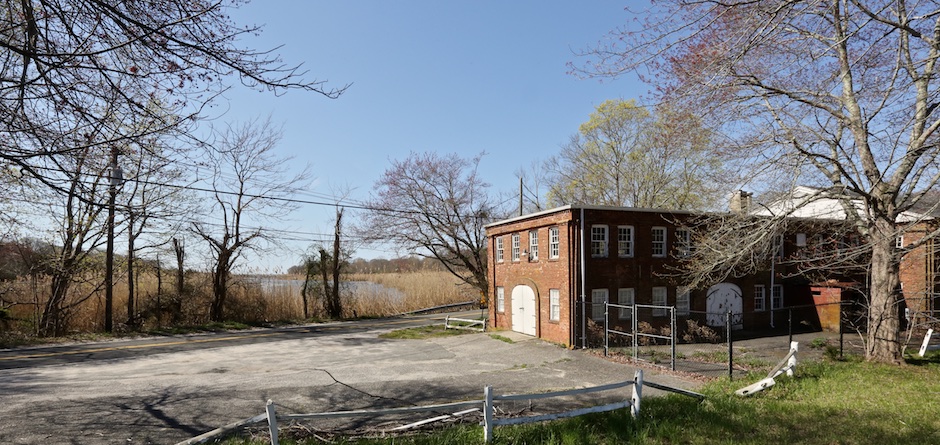
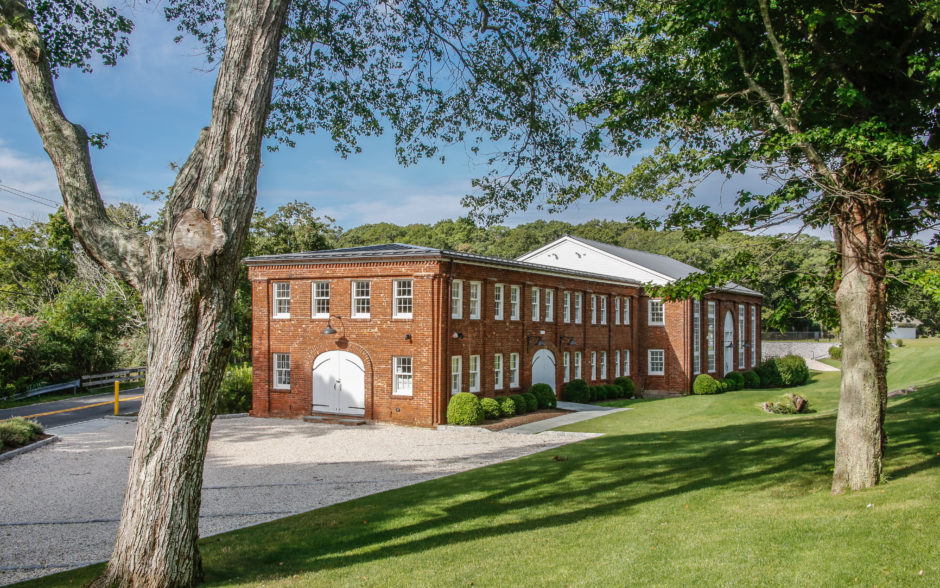
Restored, 2019.
______________________________________________

______________________________________________
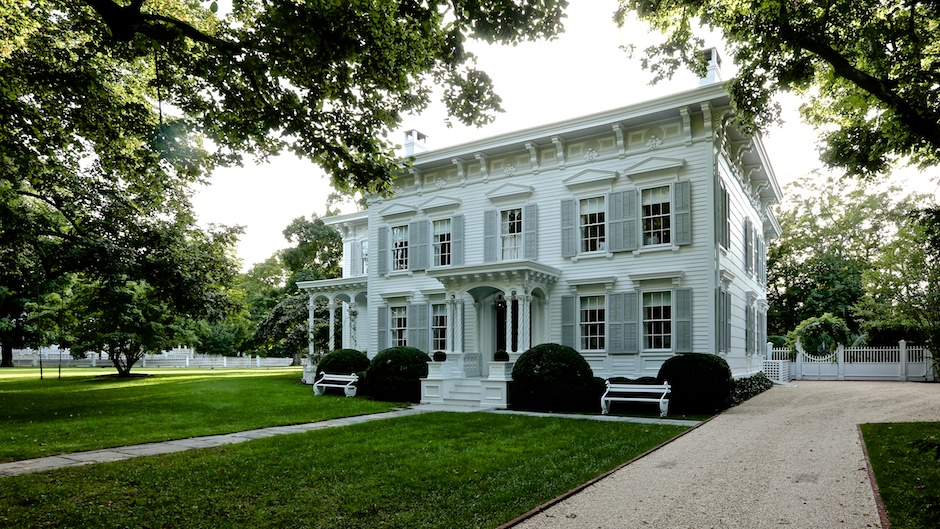
Hannibal French House, c. 1860, Sag Harbor
The Hannibal French House is elaborately Italianate Revival in style, but the structure actually encapsulates an earlier and smaller house constructed in the Federal period. Hannibal French (1817-89) had prospered from whaling and as part owner of Sag Harbor’s Maidstone Steam Flouring Mills, and despite the decline of whaling after the 1850s, enlarged his Main Street home in 1860 into a palatial village home. The deeply bracketed eaves and spiral-turned wooden posts are exceptional aspects of its design. — Historic Division, Southampton Town Clerk.
Historic Division, Southampton Town Clerk
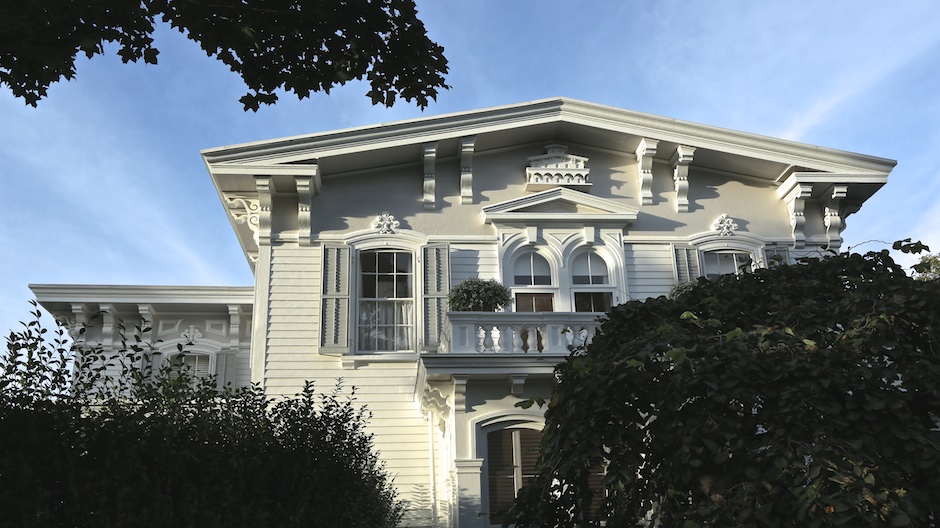
______________________________________________
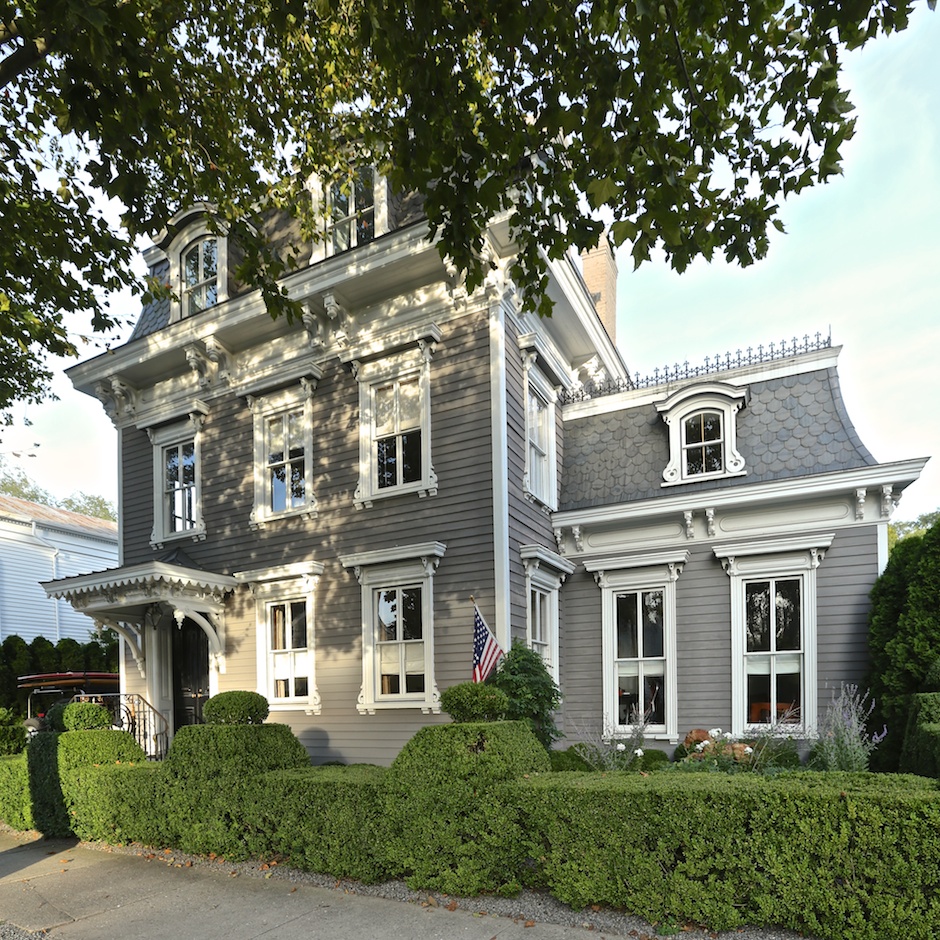
Hope House, c. 1860, Sag Harbor
Benjamin Franklin Hope, a skilled jeweler, watch and clockmaker, constructed this Victorian Second Empire style house c. 1860. Its mansard type roof is characteristic of the period, as are the paired brackets supporting the overhanging roof, 2-over-2 window sashes with molded casings and lintels, and hooded entryway. The side wing retains its ornamental roof railing. –— Historic Division, Southampton Town Clerk.
Historic Division, Southampton Town Clerk
______________________________________________

Remsenburg Academy, 1860s
The Remsenburg Academy building is an unusually fine example of the Italian villa style adapted to an institutional application. The Picturesque-style building features board and batten siding and a central tower containing a round arch entry surmounted by a roundel and paired louvered round-arches. The eaves of the tower and the main body of the building are decorated with brackets. Remsenburg Academy was built in early 1860s as a school for elite young men of New York City who boarded with local farm families. It was run by John W. Tuthill, who also taught mathematics. The school was short-lived, closing as early as1869. According to the Hamlet Heritage study, the Academy was later used as a residence, was vacant for a period of time, and served temporarily as a post office. The Remsenburg Academy Association restored the building, and it is now owned by the Town of Southampton. — Town of Southampton.
______________________________________________
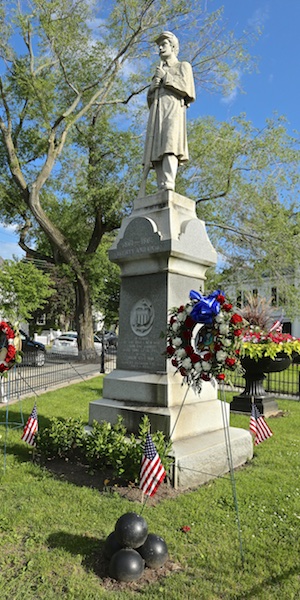
Civil War Monument, Sag Harbor
A small, triangular park surrounded by a low Victorian fence at the intersection of Main and Madison Streets contains a tall, salt-and-pepper granite Civil War Monument erected to the memory of “the brave men who from Sag Harbor bore some loyal part in the great Civil War.” The monument is surrounded by small piles of cannon balls and a mortar. In 1988, a large iron urn was dedicated by the Sag Harbor Historical Society to the memory Josephine O’Halloran Bassett (1903-1985), a long time member of the Olde Sagg Harbour Committee which worked for many years to preserve village landmarks and history prior to the creation of the historic district. — Historic Division, Southampton Town Clerk.
Historic Division, Southampton Town Clerk
______________________________________________

Monument Square, Southampton
See Monument Square, 1902, in AAQ’s Town of Southampton, 1866 — 1915 / Post-Civil War Prosperity & Immigration
___________________________________________________________________

Art & Architecture Quarterly / East End thanks the following individuals/organizations for images, information and/or assistance in the preparation of the four portfolios:
Mary Cummings, Archivist, Southampton Historical Museum for archival photos, postcards & information, and author of Southampton / Images of America / Arcadia Publishing.
Julie Greene, Collections Manager/Curator/Archivist at the Bridghampton Historical Museum, and author of Bridgehampton’s Summer Colony / Images of America / Arcadia Publishing.
Sally Spanburgh, Chairperson of the Town of Southampton Landmarks and Historic Districts Board, and author of The Southampton Cottages of Gin Lane / The History Press
Zach Studenroth, Town Historian, Historic Division, Southampton Town Clerk for Walking & Driving Tour Guides prepared in celebration of the Town of Southampton’s 375th Anniversary.
Anne Surchin, Houses of the Hamptons, co-authored with Gary Lawrance / Acanthus Press.
Town of Southampton / Historic Resources Survey Prepared by AKRF, 2014
Water Mill Museum, Water Mill
As well as, Stephanie Davis, Marsha Kenny, and Eric Woodward.
————————————————-
All photographs, except archival photographs and postcards, copyright Jeff Heatley.
————————————————-
AAQ / Resource / Education / Books
Town of Southampton / Historic Division
————————————————-
Organizations
Bridgehampton Historical Museum
John Jermain Memorial Library
Quogue Historical Society
Sag Harbor Historical Society
Southampton Historical Museum
Westhampton Beach Historical Society
As well as, the Town of Southampton and the Historic Division / Southampton Town Clerk.
———————————–
Visit related Town of Southampton Portfolios:
AAQ / Content / Preservation, Guide: Southampton Town, 1916 / 2016: Modern Era
~~~~~~~~~~~~~~~~~~~~~~~~
Suggestions / Comments: editors@aaqeastend.com
______________________________________________
